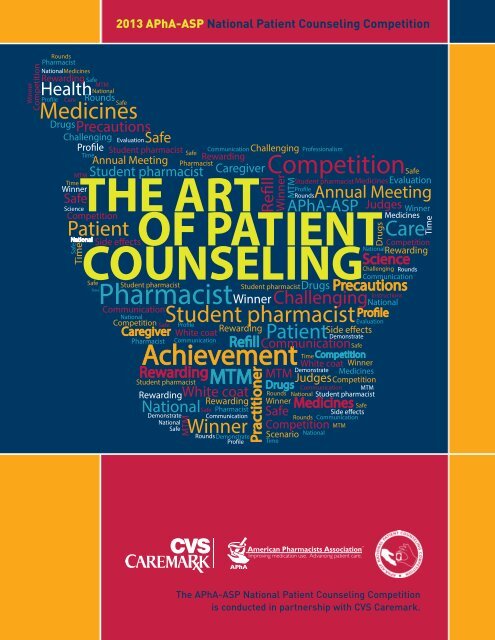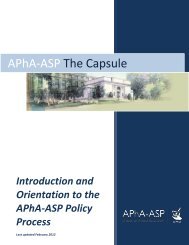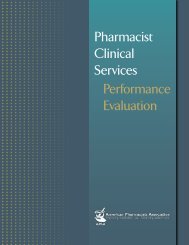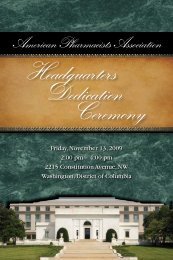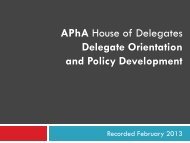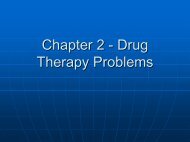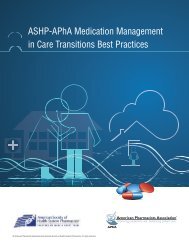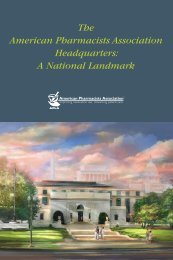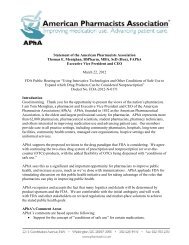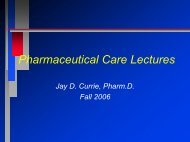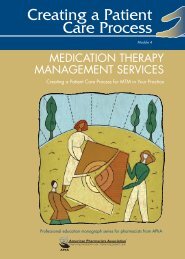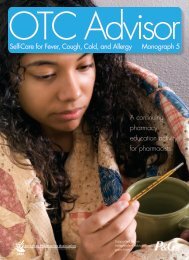the art counseling of patient - American Pharmacists Association
the art counseling of patient - American Pharmacists Association
the art counseling of patient - American Pharmacists Association
Create successful ePaper yourself
Turn your PDF publications into a flip-book with our unique Google optimized e-Paper software.
2013 APhA-ASP National Patient Counseling CompetitionTHE ARTOF PATIENTCOUNSELINGThe APhA-ASP National Patient Counseling Competitionis conducted in p<strong>art</strong>nership with CVS Caremark.
The Art <strong>of</strong> Patient Counseling 2013Important Points to RememberYour school’s winner should contact <strong>the</strong> APhANational Office (1-800-237-APhA ext. 7514) by February1, 2013 to schedule an appointment for <strong>the</strong> NationalCompetition, March 1 - 4, 2013, Los Angeles, CA.An alternate should be selected in <strong>the</strong> event that <strong>the</strong> winneris unable to attend <strong>the</strong> National Competition.P<strong>art</strong>icipants in <strong>the</strong> National Competition shouldmake flight/travel arrangements AFTER making andconfirming <strong>the</strong>ir appointment with APhA national <strong>of</strong>fice.P<strong>art</strong>icipants are encouraged to attend one <strong>of</strong> <strong>the</strong> Competitionorientation sessions: Thursday, February 28, orFriday, March 1.In order to compete in <strong>the</strong> National Competition,p<strong>art</strong>icipants must be APhA-ASP members and must beregistered for <strong>the</strong> APhA Annual Meeting & Exposition.APhA-ASP 2013 National Patient CounselingCompetition Los Angeles, CAThursday, February 28, 2013 Orientation6:00 pm - 7:00 pm Competition <strong>of</strong>fice open6:00 pm - 8:00 pm Competition orientation for students p<strong>art</strong>icipating on FridayFriday, March 1, 2013 Preliminary Round – Day One7:30 am - 5:30 pm Competition <strong>of</strong>fice open8:00 am - 5:00 pm Preliminary round <strong>of</strong> competition6:00 pm - 8:00 pm Competition orientation for students p<strong>art</strong>icipating on SaturdaySaturday, March 2, 2013 Preliminary Round – Day Two7:30 am - 4:00 pm Competition <strong>of</strong>fice open8:00 am - 4:00 pm Preliminary round continues6:00 pm Finalist list posted outside <strong>the</strong> Competition <strong>of</strong>fice and in <strong>the</strong> APhA BookstoreSunday, March 3, 2013 Final Round9:00 am - 2:00 pm Competition <strong>of</strong>fice open9:00 am - 1:00 pm Final round <strong>of</strong> competitionNPCC Awards will be presented at <strong>the</strong> APhA2013 APhA-ASP Awards Ceremony.Note: Please pick up your DVD on Sunday, March 11, 2013 at <strong>the</strong> NPCC <strong>of</strong>fice from 9:00 am - 12:00 pm.Your DVD will NOT be mailed back to you.
The Art <strong>of</strong> Patient Counseling 2013Table <strong>of</strong> contentsP<strong>art</strong> IIntroductionA. Purpose ............................... 2B. How to Use This Handbook ............... 2C. Local Competition ....................... 2D. National Competition .................... 3P<strong>art</strong> IIGuidelines for <strong>the</strong> Local CompetitionA. Planning Your Local Competition . ........... 4B. Organization . .......................... 4C. Structure .............................. 4D. Eligibility ..............................5E. Promotion ............................. 5F. Preparing for <strong>the</strong> Preliminary Round ......... 6G. Conducting <strong>the</strong> Preliminary Round .......... 7H. Preparing for <strong>the</strong> Final Round .............. 8I. Conducting <strong>the</strong> Final Round ............... 8J. The Awards Program ..................... 9P<strong>art</strong> IIIGuidelines for <strong>the</strong> NationalCompetitionA. Notifying APhA . ....................... 10B. Required Procedures . .................... 10C. Schedule and Planning ................... 10D. Conducting <strong>the</strong> NationalCompetition ........................... 10E. Awards Program ....................... 11Sample Handouts for LocalCompetitionA. Timeline for Local Competition ............. 13B. Program Committee PlanningChecklist .............................. 15Publicity Committee PlanningChecklist ............................. 16C. Finance Committee PlanningChecklist .............................. 17D. Local Winners Checklist ..................18E. Preliminary Round–Rules . ................ 19F. Preliminary Round–Instructionsfor Patients . ........................ 20G. Preliminary Round–Instructionsfor Judges ............................ 21H. Preliminary Round–Evaluation Form . . . . . . . . 22I. Final Round–Rules ...................... 23J. Final Round–Instructions for Patients ....... 24K. Final Round–Instructions for Judges ........ 25L. Final Round–Evaluation Form ............. 26M. Evaluation Form Criteria ................. 27N. Competition Announcement ............... 29O. Preliminary Round–Sign-Up Sheet .......... 30P. Final Round–Sign-Up Sheet ............... 31Q. Awards Ceremony Announcement .......... 32R. Blank Prescription Form .................. 33S. Blank Patient Pr<strong>of</strong>ile Sheet ................ 34P<strong>art</strong> IVHistory <strong>of</strong> <strong>the</strong> CompetitionA. Background . .......................... 351
The Art <strong>of</strong> Patient Counseling 2013P<strong>art</strong> IIntroductionA. PurposeThe purpose <strong>of</strong> this introduction is to give an overview<strong>of</strong> <strong>the</strong> entire program so that those involved will know howeach activity fits into <strong>the</strong> overall framework <strong>of</strong> <strong>the</strong> program.Problems are certain to arise, and some <strong>of</strong> <strong>the</strong>m may not becovered in <strong>the</strong> guidelines included in this handbook. Therefore,<strong>the</strong> person who directs <strong>the</strong> program at each school or college <strong>of</strong>pharmacy should have an understanding <strong>of</strong> <strong>the</strong> basic philosophyunderlying <strong>the</strong> program. This will make <strong>the</strong> guidelines moremeaningful and will assist in adapting <strong>the</strong> program to meet <strong>the</strong>p<strong>art</strong>icular needs <strong>of</strong> each college.B. How to Use this HandbookThe purpose <strong>of</strong> this handbook is to present rules, and providematerial for chapters to use in organizing and conducting <strong>the</strong>irlocal competitions. This handbook also gives guidelines for p<strong>art</strong>icipationin <strong>the</strong> National Competition, along with <strong>the</strong> history<strong>of</strong> <strong>the</strong> National Competition.Read this handbook before any planning, especially P<strong>art</strong> II,“Guidelines for <strong>the</strong> Local Competition.” It is essential that <strong>the</strong>competition director be familiar with <strong>the</strong> competition’s goalsand background. These guidelines are examples that should besuitable for most schools, but changes may need to be madefor each p<strong>art</strong>icular school. When making adjustments, keep inmind that modifications to <strong>the</strong> local competition that do notadequately reflect <strong>the</strong> National Competition’s procedures mayput students from that school at a disadvantage in <strong>the</strong> NationalCompetition.Follow <strong>the</strong> timeline. The timeline can serve as an excellentgauge for <strong>the</strong> progression <strong>of</strong> events which lead to a successfulcompetition. The timeline should be customized to a p<strong>art</strong>icularchapter’s needs. The director should copy <strong>the</strong> timeline for anycommittees and/or volunteers. It is also recommended that <strong>the</strong>competition director copy all <strong>of</strong> P<strong>art</strong> II, “Guidelines for <strong>the</strong> LocalCompetition,” for any committee chairmen or co-directors.Use <strong>the</strong> committee checklists. To ensure that essentialdetails have not been overlooked. Make a copy <strong>of</strong> <strong>the</strong> checklistfor each committee and <strong>the</strong> competition director. The checklistsshould be customized to a p<strong>art</strong>icular chapter's needs, perhaps byusing items on <strong>the</strong> customized timeline as a guide.Use <strong>the</strong> competition announcements. These are greattime-savers for <strong>the</strong> publicity committee. Try using differentcolor paper for <strong>the</strong> preliminary round, final round, and awardsceremony announcements to clearly distinguish <strong>the</strong> announcementsfrom one ano<strong>the</strong>r.Also provided in this handbook are instructions for <strong>the</strong> p<strong>art</strong>icipants,judges, and <strong>patient</strong>s for <strong>the</strong> local competitions, andguidelines for conducting <strong>the</strong> awards ceremony.If you have any questions about <strong>the</strong> handbook, <strong>the</strong> rules or procedures,do not hesitate to contact <strong>the</strong> <strong>American</strong> <strong>Pharmacists</strong> <strong>Association</strong>Academy <strong>of</strong> Student <strong>Pharmacists</strong> (APhA–ASP), Dep<strong>art</strong>ment<strong>of</strong> Student Development, at 1-800-237-APhA, ext. 7514.C. Local CompetitionEach year, APhA will provide each chapter with importantinformation about <strong>the</strong> year’s competition. This will include <strong>the</strong>date and place <strong>of</strong> <strong>the</strong> National Competition, <strong>the</strong> deadline bywhich APhA must receive notification <strong>of</strong> intent to p<strong>art</strong>icipate,and any changes that have been made in competition proceduressince <strong>the</strong> previous year. APhA will be available to provide <strong>the</strong>chapters with assistance if problems <strong>of</strong> any nature develop in <strong>the</strong>local competitions.There will undoubtedly be unforeseeable dilemmas that willdevelop on <strong>the</strong> local level that will not have been dealt within this handbook. Should <strong>the</strong>re be <strong>the</strong> need for a judgment ona p<strong>art</strong>icular situation or a clarification <strong>of</strong> a matter not clearlyaddressed in <strong>the</strong> handbook, APhA should be consulted. All decisionsconcerning procedures, rules, and policies will be handledby APhA. Decisions made by APhA are final.The competition itself, from <strong>the</strong> preliminary round through2
The Art <strong>of</strong> Patient Counseling 2013P<strong>art</strong> I Introduction<strong>the</strong> awards program, should span no longer than two to threeweeks, in order to maintain student interest. Both <strong>the</strong> preliminaryand <strong>the</strong> final rounds <strong>of</strong> <strong>the</strong> competition should be recordedand judged. The preliminary round will be a screening mechanismusing simple <strong>patient</strong>-<strong>counseling</strong> scenarios. The mock<strong>patient</strong> in <strong>the</strong> preliminary round should not initiate interactionwith <strong>the</strong> pharmacist. The final round should be more involvedand <strong>the</strong> mock <strong>patient</strong> should display various personality characteristicsthat will challenge <strong>the</strong> p<strong>art</strong>icipant’s ability to conveypertinent information. The final round will require <strong>the</strong> ranking<strong>of</strong> all p<strong>art</strong>icipants. No more than 10 p<strong>art</strong>icipants should beadmitted to <strong>the</strong> final round. The top ten finalists will receiveprizes compliments <strong>of</strong> APhA. You must be an APhA memberto p<strong>art</strong>icipate in <strong>the</strong> competition.D. National CompetitionThe National Competition is held during APhA's Annual Meeting,and resembles <strong>the</strong> local competition. However, <strong>the</strong> scenarioswill be more difficult to reflect <strong>the</strong> higher level <strong>of</strong> competition.P<strong>art</strong>icipants will be recorded and judged by nationally prominentpharmacy pr<strong>of</strong>essionals. Both <strong>counseling</strong> method and content willbe evaluated. Awards will be presented during <strong>the</strong> APhA–ASPAwards Ceremony.3
The Art <strong>of</strong> Patient Counseling 2013P<strong>art</strong> IIGuidelines for <strong>the</strong>Local CompetitionA. Planning Your CompetitionPlanning for <strong>the</strong> local competition should begin as early in<strong>the</strong> semester as possible. A director should be designated andcommittees or individuals should be appointed to oversee p<strong>art</strong>icularaspects <strong>of</strong> <strong>the</strong> competition. Promotion and publicity areimportant, since this is an activity with which <strong>the</strong> students maybe unfamiliar. The competition should be scheduled at a timewhen <strong>the</strong>re are a limited number <strong>of</strong> o<strong>the</strong>r activities. Two weeksafter mid-terms is usually a good time. The sign-up periodshould last two weeks, although most students will wait until<strong>the</strong> last minute to sign up.B. OrganizationAPhA-ASP chapters are responsible for organizing and conducting<strong>the</strong> competition at <strong>the</strong> local level. This is a competitiveactivity, so it is important that it be conducted fairly, with anequal opportunity for p<strong>art</strong>icipants to compete and win. Changesin this handbook's procedures should be made only after assuringthat <strong>the</strong> content <strong>of</strong> <strong>the</strong> program remains <strong>the</strong> same.For <strong>the</strong>re to be acceptance <strong>of</strong> <strong>the</strong> competition by <strong>the</strong> studentsas a whole, it is im portant that <strong>the</strong> competition be understoodby <strong>the</strong> students, that it be perceived as an enjoyable and worthwhileexperience, and that it have <strong>the</strong> appearance <strong>of</strong> being wellrun.Effective organization can assure that <strong>the</strong>se objectives aremet.The chapter advisor at each college <strong>of</strong> pharmacy will receivecopies <strong>of</strong> <strong>the</strong> <strong>patient</strong> <strong>counseling</strong> competition handbook. Thishandbook is updated annually.Each APhA-ASP chapter advisor will also receive a video <strong>of</strong><strong>the</strong> previous year's Na tional Competition finalists in order topromote p<strong>art</strong>icipation in <strong>the</strong> local competition, and to use it asa teaching tool.One person should be designated as <strong>the</strong> director <strong>of</strong> <strong>the</strong>Patient Counseling Competition each year. This person may be astudent volunteer, <strong>the</strong> APhA-ASP chapter advisor, or ano<strong>the</strong>rfaculty member. The director <strong>of</strong> <strong>the</strong> competition organizes andcoordinates <strong>the</strong> competition and handles communications withAPhA-ASP.An initial organizational meeting should be held by <strong>the</strong>APhA-ASP chapter and o<strong>the</strong>r interested p<strong>art</strong>ies as early aspossible in <strong>the</strong> school year. Planning should be well underway by three months prior to <strong>the</strong> deadline to schedule <strong>the</strong>appointment for <strong>the</strong> National Competition with <strong>the</strong> APhA-ASP National Office.Timing <strong>of</strong> <strong>the</strong> competition will depend on o<strong>the</strong>r campusactivities. The best time is following mid-semester examsduring <strong>the</strong> first semester. The sign-up period would beginimmediately following mid-semester exams and would last fortwo weeks. The timeline will be helpful in determining whento schedule <strong>the</strong> competition.C. StructureA program director should be designated as early as possibleand volunteers for specific functions should be recruited. Thedirector's job is both challenging and rewarding—<strong>the</strong> directoris <strong>the</strong> leader and organizer. The director must know whatresources are available, both in personnel and finance, in orderto delegate tasks appropriately.Three committees should be established and committeechairs selected.The Finance Committee should obtain funding for <strong>the</strong> localcompetition and funds to help defray <strong>the</strong> expenses <strong>of</strong> sending <strong>the</strong>local winner to <strong>the</strong> National Competition. Chapters must locatefinancial resources for local prizes and travel costs. Optimally,$1,000 is <strong>the</strong> recommended total for prizes and any additionalfunds should be allocated for travel assistance to <strong>the</strong> APhA AnnualMeeting. If internal resources are inadequate to handle <strong>the</strong> expenses<strong>of</strong> <strong>the</strong> competition, a community pharmacy, chain pharmacy or a4
The Art <strong>of</strong> Patient Counseling 2013P<strong>art</strong> II Guidelines for <strong>the</strong> Local Competitionstate or local pharmacy association may be able to help. When allelse fails, bake sales and car washes are good sources <strong>of</strong> revenue.The Publicity Committee needs to begin work early.There will be three periods <strong>of</strong> time when this committee willbe most needed: early in <strong>the</strong> semester, during <strong>the</strong> sign-upperiod, and immediately prior to <strong>the</strong> awards program.The Program Committee has <strong>the</strong> most time-consumingjob and will require <strong>the</strong> most manpower. This committee mustorganize and conduct <strong>the</strong> first and second rounds, includingsign-up, preparation <strong>of</strong> scenarios, <strong>counseling</strong> sessions, andjudging. The program committee will organize and run <strong>the</strong>awards program, which is a great opportunity to developstudent interest and create anticipation for <strong>the</strong> next year'scompetition. There is a short period <strong>of</strong> time to accomplish alarge number <strong>of</strong> objectives, so it is crucial that <strong>the</strong> programcommittee plan far in advance.The director coordinates <strong>the</strong> activities <strong>of</strong> <strong>the</strong> individualcommittees through <strong>the</strong> committee chairs. Good communicationbetween <strong>the</strong> committee chairs and <strong>the</strong> competition directoris essential to keep things running as smoothly as possible.The committees should meet on a regular basis, at least onceevery week or two, to report any problems and to assess <strong>the</strong>irprogress.The director also serves as a trouble shooter for <strong>the</strong> competition,so <strong>the</strong> ability to predict problem areas is an invaluableasset. Just as <strong>the</strong> director serves as a motivator and coordinatorfor <strong>the</strong> entire local competition, <strong>the</strong> individual committeechair’s role in <strong>the</strong> success <strong>of</strong> <strong>the</strong> competition cannot beoveremphasized. The committee chair must maintain frequentcommunication with committee members. Again, it is stressedthat regular committee meetings are a proven means for maintaininggood communication lines.D. EligibilityStudents become eligible in <strong>the</strong>ir first pr<strong>of</strong>essional year andremain so until obtaining <strong>the</strong>ir first degree in pharmacy. Post-Baccalaureate Pharm.D. students are ineligible for <strong>the</strong> competition.Eligible students who are on clerkships may p<strong>art</strong>icipate.December graduates may p<strong>art</strong>icipate, even though <strong>the</strong>y willhave graduated prior to <strong>the</strong> National Competition. The previousyear's National Winner is not eligible to compete in <strong>the</strong> competition.Students must be members <strong>of</strong> APhA-ASP to p<strong>art</strong>icipateat <strong>the</strong> local and national levels <strong>of</strong> <strong>the</strong> competition.E. PromotionPublicity should begin as early as possible. It would bebest to familiarize eligible students with <strong>the</strong> concept <strong>of</strong> <strong>the</strong>competition during <strong>the</strong> early p<strong>art</strong> <strong>of</strong> <strong>the</strong> fall semester.Although <strong>the</strong> primary target <strong>of</strong> promotional efforts shouldbe students who are eligible to compete, students who are notyet eligible should also be informed <strong>of</strong> <strong>the</strong> nature <strong>of</strong> <strong>the</strong> competitionand what <strong>the</strong>y have to look forward to in <strong>the</strong> future.Several large posters and flyers publicizing <strong>the</strong> competitionwill be distributed to each school by APhA. These materialscan be distributed in class and hung on bulletin boards around<strong>the</strong> school. Place advertisements in student newspapers. It isvirtually impossible to over promote <strong>the</strong> program.Promotion <strong>of</strong> <strong>the</strong> contest to students should be done by <strong>the</strong>students <strong>the</strong>mselves. It is important that this program be clearlyidentified as a student activity conducted by APhA and not beperceived as a faculty activity. Find a time when all members<strong>of</strong> <strong>the</strong> eligible classes can view <strong>the</strong> video <strong>of</strong> <strong>the</strong> previous year’snational winner, such as an APhA-ASP chapter meeting or aDean’s hour. This video will be provided with <strong>the</strong> chapter advisor’scopy <strong>of</strong> <strong>the</strong> Patient Counseling Competition Handbook.5
The Art <strong>of</strong> Patient Counseling 2013P<strong>art</strong> II Guidelines for <strong>the</strong> Local CompetitionAlso, have students who have p<strong>art</strong>icipated in <strong>the</strong> competitionbefore tell how <strong>the</strong> experience may have helped <strong>the</strong>m.The Patient Counseling Competition should be presentedto <strong>the</strong> students as an opportunity for personal growth and achance to become recognized as skillful communicators. Thecash prizes should be emphasized, but <strong>the</strong> trip to <strong>the</strong> APhAAnnual Meeting for <strong>the</strong> winner will probably be <strong>the</strong> mostimpressive material reward. Optimally, <strong>the</strong> recommended cashprizes are $250 for <strong>the</strong> winner, $125 for <strong>the</strong> first runner-up,$75 for <strong>the</strong> second runner-up, and $50 for <strong>the</strong> third runner-up.It should be stressed at all times that <strong>the</strong> competition is a nonthreateningactivity. No one will grill <strong>the</strong> students or attempt toembarrass <strong>the</strong>m.The competition should be promoted to pharmacy facultyas well as students. A representative <strong>of</strong> <strong>the</strong> APhA-ASP chaptershould attempt to address a faculty meeting, give a briefpresentation including <strong>the</strong> video, and <strong>the</strong>n respond to questions.Faculty can be very influential in encouraging studentsto p<strong>art</strong>icipate and providing <strong>the</strong>m with information about <strong>the</strong>competition. Also inform <strong>the</strong>m that APhA will provide each <strong>of</strong><strong>the</strong> top 10 finalists with a selection <strong>of</strong> book prizes.F. Preparing for <strong>the</strong>Preliminary RoundSign-up lists for <strong>the</strong> preliminary round should be posted in areadily accessible area two weeks prior to <strong>the</strong> competition. Signupswill probably not occur in great numbers at <strong>the</strong> beginning<strong>of</strong> <strong>the</strong> two-week period. Announcements to appropriate classesshould be made during <strong>the</strong> sign-up period. The director shouldpost <strong>the</strong> sign-up list with times for reference and ask <strong>the</strong> studentsto arrive 10 minutes early, dressed pr<strong>of</strong>essionally.A preliminary round with more than 50 p<strong>art</strong>icipants may bedifficult to evaluate with consistency, and will require even greaterorganizational skills by <strong>the</strong> committee. If 15 or fewer sign-up, itmay be possible to conduct <strong>the</strong> competition without a preliminaryround.Scenarios for <strong>the</strong> first round should be developed by a facultymember who is familiar with actual practice situations. The scenariosshould be simple and involve information that needs to beconveyed to <strong>the</strong> <strong>patient</strong> by <strong>the</strong> pharmacist. There should not beany problems that require consultation with <strong>the</strong> prescriber. Potentialproblems, such as drug-drug or drug-food interactions shouldbe <strong>of</strong> a minor nature that can be resolved by <strong>the</strong> pharmacist inconsultation with <strong>the</strong> <strong>patient</strong>.A mock pharmacy should be set up ei<strong>the</strong>r at <strong>the</strong> school's modelpharmacy or in a class room. All that is necessary are a counterand reference sources. The references can be books, electronics<strong>of</strong>tware, loose-leaf sources, rolodex systems, or handout leaflets.Students will not be allowed to bring <strong>the</strong>ir own materials to <strong>the</strong>competition. Audiovisual equipment should be arranged for inadvance and should be checked prior to its use. It is advisableto use a video recording system that judges may use to view <strong>the</strong>p<strong>art</strong>icipants from home. Alternatively, <strong>the</strong> chapter may wish tohost a meeting for <strong>the</strong> judges in order to provide a controlledenvironment for judging to take place. Providing refreshments isa nice touch.The PatientVolunteers should be solicited to play <strong>the</strong> role <strong>of</strong> <strong>the</strong> <strong>patient</strong>.These volunteers could be faculty members, representatives <strong>of</strong>local or state pharmacy associations, New Practitioner Mentors,graduate students, or local practitioners.Patients should be reactive but should not initiate discussionsduring <strong>the</strong> first round. The <strong>patient</strong> should appear receptiveto <strong>the</strong> information being conveyed but o<strong>the</strong>rwise shouldnot interact with <strong>the</strong> p<strong>art</strong>icipant unless a question is asked. Ifquestions are asked, <strong>the</strong> <strong>patient</strong> should provide a reasonableanswer. Patients should be familiar with <strong>the</strong> pr<strong>of</strong>ile <strong>of</strong> <strong>the</strong><strong>patient</strong> <strong>the</strong>y are playing and <strong>the</strong>y should know <strong>the</strong> appropriateresponse to questions such as "When do you usually eatdinner?" "What is your occupation?" etc. Patients should not,however, create a dilemma that is not apparent from <strong>the</strong> prescriptionand <strong>the</strong> <strong>patient</strong> pr<strong>of</strong>ile.Instructions for <strong>the</strong> <strong>patient</strong> in <strong>the</strong> preliminary round areprovided. This handout should be copied and given to <strong>the</strong><strong>patient</strong> in advance for preparation and reviewed with <strong>the</strong><strong>patient</strong> just prior to conducting <strong>the</strong> preliminary round.6
The Art <strong>of</strong> Patient Counseling 2013P<strong>art</strong> II Guidelines for <strong>the</strong> Local CompetitionThe JudgesFaculty, New Practitioner Mentors, or pharmacy graduatestudents who have a familiarity with pharmacy practice aregood choices for judges in <strong>the</strong> preliminary round. Since <strong>the</strong>purpose <strong>of</strong> <strong>the</strong> preliminary round is only to screen p<strong>art</strong>icipantsfor <strong>the</strong> finals, it is not crucial to devise a system that willaccurately distinguish <strong>the</strong> precise rank <strong>of</strong> each p<strong>art</strong>icipant.There should be a short period <strong>of</strong> time for judg ing between <strong>the</strong>preliminary round and <strong>the</strong> posting <strong>of</strong> <strong>the</strong> finalists' names. After<strong>the</strong> 10 finalists are announced, <strong>the</strong>y will need sufficient time tosign up for <strong>the</strong> final round <strong>of</strong> <strong>the</strong> competition. Therefore, availabilitywill play an important role in selecting <strong>the</strong> judges for <strong>the</strong>preliminary round.G. Conducting <strong>the</strong>Preliminary RoundStudents should arrive 10 minutes prior to <strong>the</strong>ir scheduledtime. Fifteen minutes should be allowed for each p<strong>art</strong>icipant.At <strong>the</strong> appointed time, each p<strong>art</strong>icipant will be brought into<strong>the</strong> mock pharmacy and shown <strong>the</strong> prescription counter. Afolder <strong>of</strong> <strong>patient</strong> pr<strong>of</strong>iles, a selection <strong>of</strong> references, and an emptyprescription vial should be available. The person conducting<strong>the</strong> competition should read <strong>the</strong> rules to <strong>the</strong> p<strong>art</strong>icipant.Rules for <strong>the</strong> preliminary round are provided and are suitablefor copying for <strong>the</strong> p<strong>art</strong>icipants. After reading <strong>the</strong> rules, <strong>the</strong>p<strong>art</strong>icipants have an opportunity to ask questions regarding<strong>the</strong> procedures.The person in charge should identify <strong>the</strong> p<strong>art</strong>icipant on <strong>the</strong>video, note <strong>the</strong> video counter reading, hand <strong>the</strong> appropriateprescription to <strong>the</strong> p<strong>art</strong>icipant, and indicate that <strong>the</strong> <strong>patient</strong>will arrive in five minutes. The p<strong>art</strong>icipant <strong>the</strong>n studies <strong>the</strong>prescription, <strong>the</strong> appropriate <strong>patient</strong> pr<strong>of</strong>ile, and <strong>the</strong> referencesources. After five minutes, <strong>the</strong> person in charge turnson <strong>the</strong> video recording equipment, <strong>the</strong> <strong>patient</strong> enters <strong>the</strong> mockpharmacy and approaches <strong>the</strong> counter to request <strong>the</strong> filled prescription.The p<strong>art</strong>icipant <strong>the</strong>n counsels <strong>the</strong> <strong>patient</strong> for (up to)five minutes. To assure adequate <strong>counseling</strong>, <strong>the</strong> p<strong>art</strong>icipantmust choose which facts are <strong>the</strong> most important to conveyfirst. While five minutes is a short period <strong>of</strong> time, it accuratelyreflects <strong>the</strong> maximum amount <strong>of</strong> time likely to be available in<strong>the</strong> typical practice situation.The p<strong>art</strong>icipant is given a warning when <strong>the</strong>re is only one minuteremaining. This warning can be a hand signal or any appropriatesign to advise <strong>the</strong> p<strong>art</strong>icipant that only one minute remains.After five minutes, <strong>the</strong> video recording equipment should beturned <strong>of</strong>f, whe<strong>the</strong>r or not <strong>the</strong> p<strong>art</strong>icipant is finished. The p<strong>art</strong>icipantis <strong>the</strong>n told when and where <strong>the</strong> list <strong>of</strong> finalists will be postedand that it will be necessary to sign up for <strong>the</strong> final round.It is probably best to use several different scenarios for <strong>the</strong>preliminary round. These can be numbered and <strong>the</strong> p<strong>art</strong>icipantscan select a number, or, <strong>the</strong> scenarios can be randomlyselected by <strong>the</strong> person conducting <strong>the</strong> preliminary round.The scenarios should be sufficiently similar in difficulty sothat <strong>the</strong>re will not be a p<strong>art</strong>icular advantage to choosing onescenario over ano<strong>the</strong>r.The JudgesJudges should have available to <strong>the</strong>m <strong>the</strong> following materialsduring judging: copies <strong>of</strong> all prescriptions and <strong>patient</strong>pr<strong>of</strong>iles, a copy <strong>of</strong> an appropriate drug information resourceregarding each drug for which <strong>counseling</strong> is expected, a list <strong>of</strong>p<strong>art</strong>icipants, <strong>the</strong> video counter reading at which each scenariobegins, and <strong>the</strong> prescription each p<strong>art</strong>icipant was given.Judges should also be given sufficient copies <strong>of</strong> <strong>the</strong> evaluationform, a copy <strong>of</strong> <strong>the</strong> “Instructions for Judges– PreliminaryRound,” and <strong>the</strong> evaluation form criteria. The person in chargeshould answer any questions about procedures, but shouldavoid being judgmental about individual p<strong>art</strong>icipants.After <strong>the</strong> judging, <strong>the</strong> director <strong>of</strong> <strong>the</strong> competition shouldtabulate <strong>the</strong> scores and post a list <strong>of</strong> finalists in <strong>the</strong> same placewhere <strong>the</strong> original sign-up took place. The scores should notbe posted.The director <strong>of</strong> <strong>the</strong> competition should bear in mind thatprizes from APhA will be given to each school's top 10 students.Therefore ties that would increase <strong>the</strong> number <strong>of</strong> finalistsbeyond 10 should be avoided.7
The Art <strong>of</strong> Patient Counseling 2013P<strong>art</strong> II Guidelines for <strong>the</strong> Local CompetitionH. Preparing for <strong>the</strong> Final RoundThe sign-up sheet for <strong>the</strong> final round should be posted at<strong>the</strong> same location as <strong>the</strong> sign-up sheet for <strong>the</strong> preliminaryround. A final round sign-up sheet is provided (see page 31).Announcements should be made in appropriate classes thatfinalists have been identified and that sign-ups for <strong>the</strong> finalround should be completed by a specific time. Students onclerkship should be notified directly.Scenarios for <strong>the</strong> final round should be more difficult thanfor <strong>the</strong> preliminary round. One option is to have a demonstrationincluded as p<strong>art</strong> <strong>of</strong> <strong>the</strong> scenario. The mock pharmacyshould be prepared in <strong>the</strong> same fashion as for <strong>the</strong> preliminaryround. All materials necessary for required demonstrationsshould be readily available. Audiovisual equipment is <strong>the</strong>same as <strong>the</strong> preliminary round.The <strong>patient</strong> in <strong>the</strong> final round should be a person with someacting talent in order to be able to portray a specific problemor characteristic. The director <strong>of</strong> <strong>the</strong> program should meetwith <strong>the</strong> <strong>patient</strong> to identify which personality traits <strong>the</strong> <strong>patient</strong>would feel comfortable portraying. Instructions for <strong>the</strong> finalround <strong>patient</strong> are provided. The p<strong>art</strong>icular roles to be playedby <strong>the</strong> <strong>patient</strong> should provide <strong>the</strong> p<strong>art</strong>icipants with roughly <strong>the</strong>same level <strong>of</strong> difficulty.I. Conducting <strong>the</strong> Final RoundThe final round is much <strong>the</strong> same as <strong>the</strong> preliminary round.Rules for <strong>the</strong> final round are provided.The person in charge enters <strong>the</strong> room and identifies <strong>the</strong> p<strong>art</strong>icipanton <strong>the</strong> video recorder, notes <strong>the</strong> video counter reading,hands <strong>the</strong> appropriate prescription to <strong>the</strong> p<strong>art</strong>icipant, indicateshe/she will return in five minutes, and <strong>the</strong>n leaves <strong>the</strong> modelpharmacy.P<strong>art</strong>icipants are given five minutes to review referencematerials. After this time, <strong>the</strong> <strong>patient</strong> enters <strong>the</strong> room, <strong>the</strong>recording equipment is activated, and <strong>the</strong> p<strong>art</strong>icipant isallowed five minutes to counsel <strong>the</strong> <strong>patient</strong>. Remember <strong>the</strong><strong>patient</strong> will be more difficult than <strong>the</strong> <strong>patient</strong> in <strong>the</strong> preliminaryround. The <strong>patient</strong> may be distracting or stray from <strong>the</strong>subject. It is important for <strong>the</strong> p<strong>art</strong>icipant to be sensitive to <strong>the</strong><strong>patient</strong>’s needs but to still convey <strong>the</strong> appropriate informationin <strong>the</strong> five-minute time interval. When one minute remains in<strong>the</strong> <strong>counseling</strong> session, a warning is given. After <strong>the</strong> scenariois concluded or when <strong>the</strong> five minute time limit is reached, <strong>the</strong>video recording system is shut <strong>of</strong>f. The p<strong>art</strong>icipant should betold when and where <strong>the</strong> awards program will be conductedand what to expect about <strong>the</strong> program. All p<strong>art</strong>icipants shouldattend <strong>the</strong> program.The PatientThe <strong>patient</strong> should play <strong>the</strong> role determined (e.g., angry,worried, distrustful, hearing impaired, etc.) so that <strong>the</strong> p<strong>art</strong>icipantmust work to overcome this communication obstacle, butnot so that it is impossible to communicate. The specific method<strong>of</strong> playing <strong>the</strong> role will vary from one p<strong>art</strong>icipant to ano<strong>the</strong>r.It is difficult to maintain a consistent approach, but it is veryimportant to avoid being overly difficult with good communicatorsand overly compliant with poor communicators. Perhaps<strong>the</strong> most significant potential pitfall <strong>of</strong> <strong>the</strong> entire competition isa <strong>patient</strong> whose role-playing prejudices <strong>the</strong> outcome.When one minute remains in <strong>the</strong> <strong>counseling</strong> session, a warningis given. After <strong>the</strong> scena rio is concluded or when <strong>the</strong> fiveminute time limit is reached, <strong>the</strong> video recording system is shut<strong>of</strong>f. The p<strong>art</strong>icipant should be told when and where <strong>the</strong> awardsprogram will be conducted and what to expect at <strong>the</strong> program.All p<strong>art</strong>icipants should attend <strong>the</strong> awards program.The JudgesThe best judges for <strong>the</strong> final round are practicing pharmacistswho have a reputation for a <strong>patient</strong>-focused practice. Recruitingjudges from outside <strong>the</strong> college adds credibility to <strong>the</strong> competitionand it reduces <strong>the</strong> possibility <strong>of</strong> bias from internal judgeswho know <strong>the</strong> students. It is important to contact judges earlyto assure <strong>the</strong>ir availability. Some judges may need to view <strong>the</strong>8
The Art <strong>of</strong> Patient Counseling 2013P<strong>art</strong> II Guidelines for <strong>the</strong> Local Competitionvideos at night or at home using <strong>the</strong>ir own equipment, althoughproviding a controlled environment for <strong>the</strong> judges is preferable.The most important aspect <strong>of</strong> <strong>the</strong> judging in <strong>the</strong> final roundis that <strong>the</strong>re must be no ties. Using three judges and <strong>the</strong> evaluationform included on page 26 should facilitate adequate discriminationamong <strong>the</strong> p<strong>art</strong>icipants. Instructions for <strong>the</strong> finalround judges are provided (see page 25). If a tie does occurwithin <strong>the</strong> top four finishers, some type <strong>of</strong> re-assessment shouldbe performed by <strong>the</strong> judges. It is recommended that <strong>the</strong> judgesremain anonymous—at least until after <strong>the</strong> competition.J. The Awards ProgramThe best way to stimulate interest in <strong>the</strong> competition andto encourage p<strong>art</strong>icipation in <strong>the</strong> next year's competition is toconduct an effective awards program. It is important to hold <strong>the</strong>awards program at a time when no o<strong>the</strong>r activities are scheduledand to limit <strong>the</strong> program to approximately 30 minutes.The awards program should be publicized to students andfaculty. A sample flyer for this purpose is provided (page 32).Since this type <strong>of</strong> program is <strong>patient</strong>-oriented, local and campusmedia may be interested in covering it as a health-related orhuman interest story. Having students contact local televisionstations could bring about surprising results.A good schedule for <strong>the</strong> awards program is as follows:(1) Welcome and explanation <strong>of</strong> <strong>the</strong> competition(2) Presentation <strong>of</strong> awards(3) Showing <strong>of</strong> <strong>the</strong> videotape <strong>of</strong> <strong>the</strong> first place winner(4) Brief presentation by a guest speakerThe director <strong>of</strong> <strong>the</strong> competition should conduct <strong>the</strong> awardsprogram. Awards may be presented by <strong>the</strong> APhA-ASP chapterpresident, <strong>the</strong> Dean, or an outside person. If <strong>the</strong> competitionhas been funded by an outside source, it is suggested that arepresentative <strong>of</strong> that source be involved in <strong>the</strong> awards ceremony.The guest speaker may be one <strong>of</strong> <strong>the</strong> judges or ano<strong>the</strong>rpracticing pharmacist who can make a motivational presentation.A press release should be submitted to <strong>the</strong> local mediafollowing <strong>the</strong> awards program.The chapter advisor will e-mail <strong>the</strong> top 10 finalists' contactinformation to APhA. APhA will <strong>the</strong>n contact <strong>the</strong> individualfinalists via e-mail with <strong>the</strong> instructions on how to order andreceive <strong>the</strong>ir prizes. Remember, students must be APhA membersto p<strong>art</strong>icipate in <strong>the</strong> competition.9
The Art <strong>of</strong> Patient Counseling 2013P<strong>art</strong> IIIGuidelines for <strong>the</strong>National CompetitionA. Notifying APhAThe winner must call <strong>the</strong> APhA National Office to schedulean appointment for <strong>the</strong> National Competition 1-800-237-APhA (2742), Ext.7514. An alternate should also be selectedin <strong>the</strong> event that <strong>the</strong> winner is unable to attend <strong>the</strong> NationalCompetition at <strong>the</strong> APhA2013 Annual Meeting & Expositionin Los Angeles, CA. The deadline for scheduling an appointmentis February 1, 2013.B. Required ProceduresA checklist is provided on page 18 to prepare <strong>the</strong> local winnerfor <strong>the</strong> National Competition.Each local winner must be an APhA-ASP member andmust be registered for <strong>the</strong> APhA2013 Annual Meeting &Exposition in order to compete in <strong>the</strong> National PatientCounseling Competition. The winner is responsible forcontacting <strong>the</strong> APhA National Office to schedule his or herNational Competition appointment by February 2, 2013.An alternate should also be selected in <strong>the</strong> event that <strong>the</strong> winneris unable to attend <strong>the</strong> National Competition at <strong>the</strong> APhAAnnual Meeting. A chapter may arrange financial assistance forits representative’s travel expenses to <strong>the</strong> National Competitionif funding is available. The top finishers at <strong>the</strong> National Competitionwill receive <strong>the</strong>ir cash awards after <strong>the</strong> APhA AnnualMeeting. The chapter should ensure that its representative has<strong>the</strong> financial resources necessary for <strong>the</strong> entire convention.Confirmation <strong>of</strong> <strong>the</strong> appointment time and location for <strong>the</strong>competition will be sent to <strong>the</strong> individuals along with specificdetails about <strong>the</strong> National Competition procedures. P<strong>art</strong>icipantsshould verify <strong>the</strong>ir appointment time immediatelyupon receipt <strong>of</strong> <strong>the</strong> confirmation email.Individuals p<strong>art</strong>icipating in <strong>the</strong> National Competition mustbe at <strong>the</strong> assigned location 10 minutes prior to <strong>the</strong> appointedtime. Since <strong>the</strong> competition operates under a very rigid schedule,<strong>the</strong>re will be no make-ups for missed sessions. P<strong>art</strong>icipantsare strongly encouraged to remain at <strong>the</strong> meeting for <strong>the</strong>APhA-ASP Awards Ceremony on Monday evening.C. Schedule and PlanningIt is essential that p<strong>art</strong>icipants in <strong>the</strong> National Competitionschedule <strong>the</strong>ir appointments BEFORE making airlineand hotel arrangements. Do not assume that appointmentswill be available at <strong>the</strong> local winner's convenience.Experience has shown that Friday and Saturday afternoonappointments fill-up first. If an appointment has notbeen reserved for a school or its winner and <strong>the</strong> studentis unable to compete in <strong>the</strong> remaining slots available,<strong>the</strong> student will be unable to p<strong>art</strong>icipate in <strong>the</strong> NationalCompetition.To allow ample time for judging, <strong>the</strong> National Competitionpreliminary round will begin on Friday morning and runthrough Saturday afternoon. The final round will be held onSunday morning. P<strong>art</strong>icipants will know Saturday eveningwhe<strong>the</strong>r <strong>the</strong>y have advanced to <strong>the</strong> final round. The APhA-ASP Awards Ceremony will be held Monday evening.Each p<strong>art</strong>icipant will also receive a list <strong>of</strong> 10 medicationsfrom which <strong>the</strong> medications for <strong>the</strong> preliminary and finalrounds will be chosen.D. Conducting <strong>the</strong> NationalCompetitionThe National Competition will be conducted in a similarmanner to <strong>the</strong> local competition, only more challenging.Students are encouraged but not mandated to attend <strong>the</strong>orientation. The orientation will prepare <strong>the</strong> student as wellas allow <strong>the</strong>m to become familiarized with <strong>the</strong> filming room.Students will be briefed by <strong>the</strong> on-site coordinator on <strong>the</strong> com-10
The Art <strong>of</strong> Patient Counseling 2013P<strong>art</strong> III Guidelines for <strong>the</strong> National Competitionpetition rules and procedures before <strong>the</strong>ir <strong>counseling</strong> sessionsbegin. The rules are few and <strong>the</strong> directions are intentionallysomewhat ambiguous to allow for discretionary creativity on<strong>the</strong> p<strong>art</strong> <strong>of</strong> <strong>the</strong> student relative to <strong>the</strong> elements <strong>of</strong> a positivepharmacist/<strong>patient</strong> interaction. The student will be allowedfive minutes to consult drug information resources and fiveadditional minutes for <strong>counseling</strong> <strong>the</strong> <strong>patient</strong>, who will berole-playing a specified character. All <strong>counseling</strong> sessions willbe videotaped. The decisions <strong>of</strong> <strong>the</strong> judges will be final.All finalists will receive a framed lithograph. Second, third,and fourth prizes are $700, $500, and $300, respectively.Mementos will be given to all p<strong>art</strong>icipants.APhA will publicize <strong>the</strong> competition and <strong>the</strong> winners to <strong>the</strong>state and national pharmacy media.E. Awards ProgramThe winner <strong>of</strong> <strong>the</strong> National Competition will receive $1,000and a National Patient Counseling Competition plaque with<strong>the</strong> winner's name engraved on <strong>the</strong> front. It is a tradition that<strong>the</strong> winner <strong>of</strong> <strong>the</strong> National Patient Counseling Competition beinvited back <strong>the</strong> following year to serve as a judge for <strong>the</strong> nextNational Competition. The winner’s school will receive a replica<strong>of</strong> <strong>the</strong> National Patient Counseling Trophy.11
The Art <strong>of</strong> Patient Counseling 2013SampleHandouts for Local CompetitionThese resources can be copied and used for instruction and publicity before and during<strong>the</strong> local competition.• Timeline for Local Competition (page 13)• Program Committee Planning Checklist (page 15)• Publicity Committee Planning Checklist (page 16)• Finance Committee Planning Checklist (page 17)• Local Winner Checklist (page 18)• APhA-ASP Rules for <strong>the</strong> Patient Counseling Competition – Preliminary Round (page 19)• Instructions for Patients – Preliminary Round (page 20)• Instructions for Judges – Preliminary Round (page 21)• APhA-ASP Patient Counseling Competition Evaluation Form – Preliminary Round (page 22)• APhA-ASP Rules for <strong>the</strong> Patient Counseling Competition – Final Round (page 23)• Patient Counseling Competition Instructions for Patients – Final Round (page 24)• Patient Counseling Competition Instructions for Judges – Final Round (page 25)• APhA - ASP Patient Counseling Competition Evaluation Form – Final Round (page 26)• Evaluation Criteria – Final Round (page 27)• Announcement Handout (page 29)• Sign - Up Sheet – Preliminary Round (page 30)• Final Round List (page 31)• Awards Ceremony Announcement (page 32)• Blank Prescription Form (page 33)• Blank Patient Pr<strong>of</strong>ile Sheet (page 34)12
The Art <strong>of</strong> Patient Counseling 2013Sample handouts for local competitionTimeline for Local CompetitionTime Out/DateCompetition DirectorT – 11 Weeks/_____T – 10 Weeks/_____• Announce competition & recruit volunteers• Notify school personnel responsible for extracurricular activities <strong>of</strong> <strong>the</strong> datesand times <strong>of</strong> <strong>the</strong> competitions and awards ceremony• Organize meeting to determine budget• Set up Program Committee, Publicity Committee, and Finance CommitteeTime Out/Date Program Committee Publicity Committee Finance CommitteeT – 9 Weeks/_____Committee meets to assignresponsibilitiesCommittee meets toassign responsibilitiesCommittee meets to assignresponsibilitiesT – 8 Weeks/_____Determine potential judges,<strong>patient</strong>s, and scenarioauthorInvestigate publicityopportunities in schoolnewspaperContact alumni, stateassociation, pharmacies,etc. to seek supportT – 7 Weeks/_____Scenario authorconfirmedContact local press forhuman interest storycoverage and o<strong>the</strong>ropportunitiesPlan fundraisersT – 6 Weeks/_____Keynote speaker for awardsceremony selected; programwrittenPlan fundraisersT – 5 Weeks/_____Scenarios written; judges,<strong>patient</strong>s, confirmed inwritingPosters and announcementsdistributed to promotefundraisersPlanning for fundraiserscompleteT – 4 Weeks/_____Arrangements for judgingrooms and AV equipmentcompleteAddress faculty meeting;show video; givepresentation13
The Art <strong>of</strong> Patient Counseling 2013Sample handouts for local competitionFinance Committee Planning ChecklistDeadline(from timeline) ✓ Check box when completedPossible financial supporters contacted:deanalumni associationstate and local associationspharmaceutical industry companiesindividual pharmacistslocal chain drug storespharmaceutical wholesaler /distributorso<strong>the</strong>ro<strong>the</strong>rFundraiser planned:ideas generated and finalizedlocations confirmeddate setdetails communicated to publicity committeeextra volunteers recruitedspecial materials obtainedo<strong>the</strong>ro<strong>the</strong>rFinance committee’s details <strong>of</strong> awards ceremony finished:supporters invitedchecks obtained for winnersletters <strong>of</strong> appreciation sent to supportersWinner prepared for National Competition:appointment time reserved (by calling APhA no later than February 1, 2013)registered for APhA Annual Meetingmembership in APhA-ASP confirmed17
The Art <strong>of</strong> Patient Counseling 2013Sample handouts for local competitionAPhA-ASP Rules for <strong>the</strong> Patient Counseling CompetitionPreliminary RoundThe purpose <strong>of</strong> this competition is to measure your abilitiesas a communicator <strong>of</strong> information about medications to<strong>patient</strong>s. You will be given a prescription order and you willbe allowed five minutes to consult <strong>the</strong> <strong>patient</strong> pr<strong>of</strong>iles and anyreference sources available within <strong>the</strong> model pharmacy. Afterfive minutes, <strong>the</strong> <strong>patient</strong> will arrive to be counseled. You willnot be required to actually fill <strong>the</strong> prescription. When youcounsel <strong>the</strong> <strong>patient</strong>, you may use an empty prescription vialto simulate <strong>the</strong> filled prescription. You may communicateto <strong>the</strong> <strong>patient</strong> orally and by using written information. Youmay ask questions <strong>of</strong> <strong>the</strong> <strong>patient</strong>. You will be limited to fiveminutes for <strong>counseling</strong>. A warning will be given when oneminute remains in <strong>the</strong> <strong>counseling</strong> session. In your <strong>counseling</strong>session, you should cover any problems raised by <strong>the</strong> prescriptionorder itself, by <strong>the</strong> <strong>patient</strong> pr<strong>of</strong>ile, or by something said by<strong>the</strong> <strong>patient</strong>. You may ask questions <strong>of</strong> <strong>the</strong> competition directoruntil you are given <strong>the</strong> prescription and <strong>patient</strong> pr<strong>of</strong>ile. Afteryou are given this information, you may not ask questionsabout <strong>the</strong> competition procedure. The decision <strong>of</strong> <strong>the</strong> competitionjudges is final.19
The Art <strong>of</strong> Patient Counseling 2013Sample handouts for local competitionInstructions for Patients— Preliminary RoundAs a <strong>patient</strong>, your role is key to <strong>the</strong> success <strong>of</strong> <strong>the</strong> NationalPatient Counseling Competition. It is very important thatyour role playing be consistent from p<strong>art</strong>icipant to p<strong>art</strong>icipant.Perhaps <strong>the</strong> most significant potential pitfall <strong>of</strong> <strong>the</strong> entire competitionis a <strong>patient</strong> whose role-playing prejudices <strong>the</strong> outcome.The purpose <strong>of</strong> <strong>the</strong> preliminary round is to distinguish10 p<strong>art</strong>icipants who will advance to <strong>the</strong> final round.You should react to <strong>the</strong> p<strong>art</strong>icipant, but you should not initiatesuperfluous discussions during this round <strong>of</strong> <strong>the</strong> competition.You should answer questions by <strong>the</strong> p<strong>art</strong>icipant but, naturally,<strong>the</strong>re should be no attempt to "sandbag" or confuse <strong>the</strong>p<strong>art</strong>icipant. You should appear receptive to <strong>the</strong> informationbeing conveyed but o<strong>the</strong>rwise not interact with <strong>the</strong> p<strong>art</strong>icipantunless a question is asked. If questions are asked, you shouldprovide a reasonable answer. You should be familiar with <strong>the</strong><strong>patient</strong> pr<strong>of</strong>ile and know appropriate answers to questionssuch as, "When do you usually eat dinner?", "What is youroccupation?", etc. You should not, however, create a dilemmathat is not apparent from <strong>the</strong> prescription and <strong>patient</strong> pr<strong>of</strong>ile.Thank you for being a <strong>patient</strong> for our competition. We hope<strong>the</strong> experience is an enjoyable one.20
The Art <strong>of</strong> Patient Counseling 2013Sample handouts for local competitionInstructions for Judges—Preliminary RoundAs a judge <strong>of</strong> <strong>the</strong> preliminary round <strong>of</strong> <strong>the</strong> Patient CounselingCompetition, you will be responsible for screening <strong>the</strong>videos <strong>of</strong> all p<strong>art</strong>icipants and determining which p<strong>art</strong>icipantswill be selected to p<strong>art</strong>icipate in <strong>the</strong> final round <strong>of</strong> <strong>the</strong> competition.The evaluations <strong>of</strong> all judges will be averaged toge<strong>the</strong>r todetermine <strong>the</strong> ten highest rated p<strong>art</strong>icipants.Providing fair, imp<strong>art</strong>ial, and efficient judgments is a difficulttask. Some judges tend to be too harsh (perhaps forgettingthat <strong>the</strong>y are evaluating student pharmacists) while o<strong>the</strong>rs tendto be too lenient. Some judges spend hours viewing and reviewing<strong>the</strong> videos while o<strong>the</strong>rs have finished <strong>the</strong>ir evaluationsbefore <strong>the</strong> video has ended. Regardless <strong>of</strong> <strong>the</strong> specific issue, <strong>the</strong>outcome <strong>of</strong>ten is an evaluation that is unfair to <strong>the</strong> p<strong>art</strong>icipantnor <strong>the</strong> judge.In an effort to minimize some <strong>of</strong> <strong>the</strong>se problems, <strong>the</strong> followinginstructions should be read carefully and referred to ifdifficulties arise during <strong>the</strong> judging <strong>of</strong> p<strong>art</strong>icipants:1. Before viewing any videos, make sure you have a clearunderstanding <strong>of</strong> <strong>the</strong> two evalua tion criteria. You will bejudging <strong>the</strong> p<strong>art</strong>icipants on both <strong>the</strong>ir pr<strong>of</strong>essional competenceand <strong>the</strong>ir communication ability. In o<strong>the</strong>r words,you are to assess what <strong>the</strong>y say and how <strong>the</strong>y say it.2. When you judge each p<strong>art</strong>icipant, you will have tomake two separate evaluations—one for pr<strong>of</strong>essionalcompetence and one for communication ability. In eachcategory you can rate <strong>the</strong> p<strong>art</strong>icipant between 0 and 10points. A rating <strong>of</strong> 9 or 10 should be reserved forcontestants who are clearly superior while a 1 or 2 ratingshould be given to p<strong>art</strong>icipants who are consistentlyinadequate. A rating <strong>of</strong> 5 should be given for an averageperformance in ei<strong>the</strong>r category.3. With this understanding in mind, it would now be usefulto view two or three videos, not to judge <strong>the</strong>m, butto get a general sense <strong>of</strong> <strong>the</strong> level <strong>of</strong> <strong>the</strong> p<strong>art</strong>icipants'abilities.4. You should have before you <strong>the</strong> following information:(a) a list <strong>of</strong> <strong>the</strong> p<strong>art</strong>icipants, (b) <strong>the</strong> prescriptions and<strong>patient</strong> pr<strong>of</strong>iles used by each p<strong>art</strong>icipant, (c) copies <strong>of</strong> anappropriate drug information resource, and (d) evaluationforms.5. It is recommended that you view <strong>the</strong> entire <strong>counseling</strong>session (five minutes) before evaluating <strong>the</strong> p<strong>art</strong>icipant.For some judges it is helpful to review selected segmentsbefore making <strong>the</strong>ir final judgments.6. It should be remembered that this round is only a qualifyingcompetition. Your judg ments will be used todetermine which group <strong>of</strong> p<strong>art</strong>icipants will compete in<strong>the</strong> final round, not to distinguish <strong>the</strong> exact finishingorder. In most cases your instinct will provide <strong>the</strong> bestbasis for your final evaluation.21
The Art <strong>of</strong> Patient Counseling 2013Sample handouts for local competitionAPhA-ASP Patient Counseling CompetitionEvaluation Form—Preliminary RoundP<strong>art</strong>icipant Name:_______________________________________________________________Video Counter Reading:____________________________________________________________Directions: After viewing <strong>the</strong> video <strong>of</strong> each p<strong>art</strong>icipant, indicate your rating <strong>of</strong> <strong>the</strong> p<strong>art</strong>icipant's communication skills andpr<strong>of</strong>essional competence. For each category, rate <strong>the</strong> p<strong>art</strong>icipant between 0 (not done) and 10 (superior). A rating <strong>of</strong> 5indicates an average score. You may use decimals when making your final rating. The scale at <strong>the</strong> bottom <strong>of</strong> this formreflects <strong>the</strong> general levels <strong>of</strong> performance.Rating____________________________CriteriaCommunication SkillsIn rating this category, you should consider some or all <strong>of</strong> <strong>the</strong> following concerns:presents information clearly and adapts to <strong>the</strong> <strong>patient</strong>;displays appropriate nonverbal behaviors;checks for understanding;expresses interest in and concern for <strong>the</strong> <strong>patient</strong>;uses visual aids and/or written information;provides summary and opportunity for follow-upPr<strong>of</strong>essional CompetenceIn rating this category, you should consider some or all <strong>of</strong> <strong>the</strong> following concerns:asks necessary and appropriate questions;presents accurate and complete information;refers to and uses <strong>patient</strong> pr<strong>of</strong>ile informationPerformance Scale: 0 NOT DONE1-2 POOR3-4 UNSATISFACTORY5 AVERAGE6-8 SATISFACTORY9-10 EXCELLENTJudge's Name:__________________________________________________________________22
The Art <strong>of</strong> Patient Counseling 2013Sample handouts for local competitionAPhA–ASP Rules for <strong>the</strong> Patient Counseling CompetitionFinal RoundThe final round <strong>of</strong> <strong>the</strong> Patient Counseling Competition ismuch like <strong>the</strong> preliminary round, but <strong>the</strong>re are some importantdifferences. As with <strong>the</strong> preliminary round, you will be judgedon your ability to communicate information about medicationsto <strong>patient</strong>s. The evaluation will again be half on content andhalf on style. The decision <strong>of</strong> <strong>the</strong> judges will be final.In <strong>the</strong> final round, you will choose a random prescriptionfrom a bowl. You will <strong>the</strong>n have five minutes to study <strong>the</strong> prescriptionorder, <strong>the</strong> <strong>patient</strong> pr<strong>of</strong>ile, and <strong>the</strong> reference sourcesavailable. You will not be required to actually fill <strong>the</strong> prescriptionorder, but <strong>the</strong>re are several products that are on <strong>the</strong> counterwhich represent <strong>the</strong> stock in your pharmacy. You should usewhatever product is appropriate to assist you in <strong>counseling</strong> your<strong>patient</strong>. You will see that some demonstration may be required.After five minutes, <strong>the</strong> <strong>patient</strong> will arrive to be counseled.You may counsel <strong>the</strong> <strong>patient</strong> orally, by using written handoutinformation, and by demonstrating how to use <strong>the</strong> productitself. In this final round, <strong>the</strong> <strong>patient</strong> will display a personalitycharacteristic that will challenge your ability to counsel onproper use <strong>of</strong> <strong>the</strong> product. A one-minute warning will be given,and <strong>the</strong>n <strong>the</strong> technician will come in and turn <strong>of</strong>f <strong>the</strong> videorecorder after <strong>the</strong> five-minute time limit is reached.23
The Art <strong>of</strong> Patient Counseling 2013Sample handouts for local competitionInstructions for Patient—Final RoundAs a <strong>patient</strong>, your role is key to <strong>the</strong> success <strong>of</strong> <strong>the</strong> PatientCounseling Competition. It is very important that <strong>the</strong> roleplaying that you will do as a <strong>patient</strong> be consistent from p<strong>art</strong>icipantto p<strong>art</strong>icipant. Perhaps <strong>the</strong> most significant potentialpitfall <strong>of</strong> <strong>the</strong> entire competition is a <strong>patient</strong> whose role playingprejudices <strong>the</strong> outcome.The purpose <strong>of</strong> <strong>the</strong> final round is to select <strong>the</strong> winner for <strong>the</strong>competition as well as three runners-up. Because this is <strong>the</strong>final round, <strong>the</strong> situation presented to <strong>the</strong> p<strong>art</strong>icipant is morechallenging than in <strong>the</strong> preliminary round.In this round you will display a personality characteristicsuch as anger, worry, distrust, a hearing impairment, etc. Thepersonality characteristic that you will play for a p<strong>art</strong>icularp<strong>art</strong>icipant is chosen at random. You should play <strong>the</strong> selectedrole so that <strong>the</strong> p<strong>art</strong>icipant must work to overcome <strong>the</strong> communicationobstacle presented by <strong>the</strong> personality characteristic,but not so that it is impossible to communicate. The specificmethod <strong>of</strong> playing <strong>the</strong> role will vary from one p<strong>art</strong>icipantto ano<strong>the</strong>r. It is difficult to maintain a consistent approach,but it is very important to avoid being overly difficult withgood communicators and overly compliant with poor communicators.Thank you for being a <strong>patient</strong> for our competition. We hope<strong>the</strong> experience is an enjoyable one.24
The Art <strong>of</strong> Patient Counseling 2013Sample handouts for local competitionInstructions for Judges—Final RoundAs a judge <strong>of</strong> <strong>the</strong> final round <strong>of</strong> <strong>the</strong> Patient CounselingCompetition, you will be responsible for screening <strong>the</strong> videos<strong>of</strong> <strong>the</strong> finalists and providing specific ratings <strong>of</strong> each p<strong>art</strong>icipant.Your ratings and those <strong>of</strong> <strong>the</strong> o<strong>the</strong>r judges will be combinedto determine <strong>the</strong> finishing order <strong>of</strong> p<strong>art</strong>icipants.You have been selected as a judge because <strong>of</strong> your experienceand reputation as a <strong>patient</strong>-oriented practitioner. It isexpected that you have evolved your own set <strong>of</strong> standards for<strong>patient</strong> <strong>counseling</strong>. However, when evaluating <strong>the</strong> p<strong>art</strong>icipants,you will be asked to utilize <strong>the</strong> standards/criteria thathave been developed for this competition. While <strong>the</strong>se criteriamay differ slightly from your own, <strong>the</strong>y are necessary for <strong>the</strong>standardization <strong>of</strong> evaluation procedures.The following instructions have been developed to facilitatean accurate and efficient evaluation process. They shouldbe read carefully prior to viewing any videos and any questionsyou may have should be referred to <strong>the</strong> director <strong>of</strong> <strong>the</strong>competition.1. Before viewing any videos, make sure you have a clearunderstanding <strong>of</strong> <strong>the</strong> attached evaluation criteria. Youwill be judging <strong>the</strong> p<strong>art</strong>icipants on 24 attributes relatedto <strong>the</strong>ir pr<strong>of</strong>essional competence and <strong>the</strong>ir communicationability. It is essential that you are able to identifyquickly and accurately <strong>the</strong> use <strong>of</strong> <strong>the</strong>se attributes byp<strong>art</strong>icipants during <strong>the</strong>ir <strong>patient</strong> <strong>counseling</strong> sessions.2. When you judge each p<strong>art</strong>icipant, you will have to make24 separate evaluations. It is important to understandthat <strong>the</strong>se evaluations are independent. It is possible fora p<strong>art</strong>icipant to receive a low rating on one attributeand high ratings on o<strong>the</strong>rs. For each attribute, you canrate <strong>the</strong> p<strong>art</strong>icipant. A rating <strong>of</strong> 5 should be reserved fora p<strong>art</strong>icipant who is clearly superior, while a rating <strong>of</strong>0 and 2 or 0 and 5 depending on <strong>the</strong> section evaluationcriteria should be given to a p<strong>art</strong>icipant who is consistentlypoor. A rating <strong>of</strong> 3 should be given for an averageperformance on any attribute. Total evaluation scores forindividual p<strong>art</strong>icipants can range between 0 and 100.3. For <strong>the</strong> first section (Pr<strong>of</strong>essional Competence – CounselingPoints) a rating <strong>of</strong> 0 means that <strong>the</strong> p<strong>art</strong>icipantdid not complete <strong>the</strong> required portion <strong>of</strong> <strong>the</strong> <strong>counseling</strong>session. A rating <strong>of</strong> 2 signifies that <strong>the</strong> p<strong>art</strong>icipant didsuccessfully complete this <strong>counseling</strong> point. A total <strong>of</strong>100 points may be achieved after grading all three sections<strong>of</strong> <strong>the</strong> competition.4. With this understanding in mind, it would now be usefulto view two or three videos, not to judge <strong>the</strong>m, butto get a general sense <strong>of</strong> <strong>the</strong> level <strong>of</strong> <strong>the</strong> p<strong>art</strong>icipants'abilities. Remember, <strong>the</strong>se are students and not practicingpharmacists. Your judgments should reflect <strong>the</strong>comparative levels <strong>of</strong> ability <strong>of</strong> p<strong>art</strong>icipants relative to astudent's experiences.5. You should have before you <strong>the</strong> following information:(a) a list <strong>of</strong> p<strong>art</strong>icipants, (b) <strong>the</strong> video counter readingsindicating <strong>the</strong> beginning <strong>of</strong> each scenario, (c) <strong>the</strong> prescriptionsand <strong>patient</strong> pr<strong>of</strong>iles used by each p<strong>art</strong>icipant,(d) copies <strong>of</strong> an appropriate drug information resource,and (e) evaluation forms.6. It is recommended that you review <strong>the</strong> entire <strong>counseling</strong>session (five minutes) before evaluating <strong>the</strong> p<strong>art</strong>icipant.For some judges it is helpful to review selected segmentsbefore making <strong>the</strong>ir final judgments.7. This is <strong>the</strong> final round <strong>of</strong> <strong>the</strong> competition and your ratingswill be used to determine <strong>the</strong> winners. Consequently,it is crucial that your ratings clearly differentiate p<strong>art</strong>icipantsaccording to <strong>the</strong>ir ability. Understandably, this isa difficult task. However, if <strong>the</strong> summary ratings do notdiscriminate between p<strong>art</strong>icipants, it will be very difficultfor <strong>the</strong> director <strong>of</strong> <strong>the</strong> competition to determine <strong>the</strong>exact finishing order <strong>of</strong> p<strong>art</strong>icipants. In <strong>the</strong> event that <strong>the</strong>combined ratings <strong>of</strong> <strong>the</strong> judges lead to a tie, you (and <strong>the</strong>o<strong>the</strong>r judges) will be asked to reevaluate <strong>the</strong> videotapes <strong>of</strong>those p<strong>art</strong>icipants involved to break <strong>the</strong> tie.25
The Art <strong>of</strong> Patient Counseling 2013Sample handouts for local competitionAPhA-ASP Patient CounselingCompetition Evaluation Form—Final RoundP<strong>art</strong>icipant Name: _____________________________________________________ Judge’s Initials: _________________________________Directions: After reviewing <strong>the</strong> videotape, indicate your rating <strong>of</strong> <strong>the</strong> contestant’s performance by circling <strong>the</strong> appropriate number. For each item,rate <strong>the</strong> contestant from 0 (Did Not Complete) to 5 (Excellent). When you have completed <strong>the</strong> form, CHECK TO BE SURE YOU HAVE CIRCLEDA NUMBER FOR EACH ITEM.P<strong>art</strong> 1 PROFESSIONAL COMPETENCE – COUNSELING POINTS Did Not Complete Completed N/A1 Identifies/introduces self as pharmacist. 0 2 XOverall Evaluation Score2 Identifies/confirms <strong>patient</strong> or <strong>patient</strong>’s agent. 0 2 X P<strong>art</strong> 1 Score (max 20) = _____3 Provides medication name. 0 2 X P<strong>art</strong> 2 Score (max 30) = _____4 Provides indication for medication. 0 2 X P<strong>art</strong> 3 Score (max 35) = _____Overall Evaluation Score5 Provides dosage/regimen for medication. 0 2 X_____(max 15) =6 Discusses potential (major) side effects. 0 2 X Total Score = _____7 Discusses potential warnings, precautions, and interactions. 0 2 X Judges Notes:8 Describes missed dose instructions. 0 2 X9 Provides number <strong>of</strong> refills or number <strong>of</strong> allowed refills. 0 2 X10 Discusses storage recommendations. 0 2 XPART 1: TOTAL SCORE FOR PROFESSIONAL COMPETENCE – COUNSELING POINTS = ________(maximum 20 points)P<strong>art</strong> 2 PROFESSIONAL COMPETENCE – COUNSELING SESSION Did Not Complete PoorBelowAverageAverage Good Excellent N/A11 Explains <strong>the</strong> purpose <strong>of</strong> <strong>the</strong> <strong>counseling</strong> session. 0 1 2 3 4 5 X12 Makes appropriate use <strong>of</strong> <strong>the</strong> <strong>patient</strong> pr<strong>of</strong>ile. 0 1 2 3 4 5 X13 Assesses <strong>patient</strong> understanding <strong>of</strong> <strong>the</strong> reason(s) for <strong>the</strong>rapy. 0 1 2 3 4 5 X14 Uses open-ended questions throughout <strong>counseling</strong> session. 0 1 2 3 4 5 X15 Verifies <strong>patient</strong> understanding via feedback. 0 1 2 3 4 5 X16Summarizes by emphasizing key points <strong>of</strong> information, providesclosure and opportunity for follow-up.0 1 2 3 4 5 XPART 2: TOTAL SCORE FOR PROFESSIONAL COMPETENCE – COUNSELING SESSION = ________ (maximum 30 points)P<strong>art</strong> 3 COMMUNICATION ABILITY – GENERAL TECHNIQUES Did Not Complete PoorBelowAverageAverage Good Excellent N/A17 Presents facts and concepts in a logical order. 0 1 2 3 4 5 X18 Provides accurate information. 0 1 2 3 4 5 X19 Uses language <strong>the</strong> <strong>patient</strong> is likely to understand. 0 1 2 3 4 5 X20Displays effective nonverbal behaviors (eye contact, bodylanguage, etc.)0 1 2 3 4 5 X21Identifies and appropriately addresses any real or anticipatedconcerns or problems <strong>of</strong> importance.0 1 2 3 4 5 X22 Uses understanding or empa<strong>the</strong>tic responses. 0 1 2 3 4 5 X23 Maintains control and direction <strong>of</strong> <strong>the</strong> <strong>counseling</strong> session. 0 1 2 3 4 5 XPART 3: TOTAL SCORE FOR COMMUNICATION ABILITY – GENERAL TECHNIQUES = ________ (maximum 35 points)24 Overall Evaluation <strong>of</strong> p<strong>art</strong>icipant. 0 1 2 3 4 5 XTOTAL SCORE FOR OVERALL EVALUATION ________ x 3 = ________ (maximum 15 points)26
The Art <strong>of</strong> Patient Counseling 2013Sample handouts for local competitionAPhA-ASP Judges Evaluation Form CriteriaFinal Round1. Conducts appropriate <strong>counseling</strong> introduction by identifying self and <strong>the</strong> <strong>patient</strong> or <strong>patient</strong>'s agent.The health care pr<strong>of</strong>essional should introduce himself or herself to <strong>the</strong> <strong>patient</strong> or <strong>patient</strong>'s agent, and ask if <strong>the</strong> person is <strong>the</strong><strong>patient</strong>, <strong>the</strong> caregiver, or someone simply picking up <strong>the</strong> prescription for <strong>the</strong> <strong>patient</strong>.2 Conveys complete information to <strong>the</strong> <strong>patient</strong>.The health care pr<strong>of</strong>essional should convey information such as <strong>the</strong> name <strong>of</strong> <strong>the</strong> medication, indication, dosage/regimenpotential side effects, potential warnings, precaution, interactions, missed dose instructions, number <strong>of</strong> refills, storage recommendations,etc.3. Explains <strong>the</strong> purpose <strong>of</strong> <strong>the</strong> <strong>counseling</strong> session.The health care pr<strong>of</strong>essional should prepare <strong>the</strong> <strong>patient</strong> or caregiver for <strong>the</strong> information to be presented and explain why <strong>the</strong>information is important to <strong>the</strong> <strong>patient</strong>. It is important to tell <strong>patient</strong>s why <strong>the</strong> <strong>counseling</strong> session is important from <strong>the</strong>irperspective.4. Makes appropriate use <strong>of</strong> <strong>the</strong> <strong>patient</strong> pr<strong>of</strong>ile information.This involves verifying that <strong>the</strong> pr<strong>of</strong>ile information is up-to-date (current medications, etc.) and that <strong>the</strong> information pointsto any possible problems (drug-drug, drug-food, or drug-disease interactions; noncompliance).5. Assesses <strong>patient</strong>'s understanding <strong>of</strong> <strong>the</strong> reason(s) for <strong>the</strong>rapy.It is extremely useful to find out what <strong>the</strong> <strong>patient</strong> already knows. Doing this has <strong>the</strong> potential for saving time in <strong>the</strong> <strong>counseling</strong>sessions and reinforces learned information. In addition, any incorrect information could be corrected at this time. Itwould be important to assess what <strong>the</strong> <strong>patient</strong> understands about <strong>the</strong> seriousness <strong>of</strong> <strong>the</strong> illness, <strong>the</strong> treatment, dietary restrictions,etc.6. Uses open-ended questions.The use <strong>of</strong> open-ended questions (e.g., "What did your health care provider tell you this medication is for?") ra<strong>the</strong>r thanclose-ended questions (e.g., "Did your health care provider tell you what this medication is for?") helps <strong>the</strong> health care providerdetermine what information <strong>the</strong> <strong>patient</strong> needs. Answers to open-ended questions may help <strong>the</strong> health care providerdetermine <strong>the</strong> <strong>patient</strong>’s level <strong>of</strong> understanding.7. Verifies <strong>patient</strong>'s understanding, via feedback.The health care provider should verify <strong>patient</strong> understanding via <strong>patient</strong> feedback. For example, "Mrs. Jones, just to be surethat I am clear, could you tell me how you are going to take your medication?" The same would be done with side effects,missed doses, storage conditions, etc. A more direct approach would be: "Mrs. Jones, what time will you take your firstdose?" Correct answers can be praised and incorrect information can be corrected. Praising has been shown to reinforceadherence.8. Summarizes by emphasizing key points <strong>of</strong> information.The health care provider should summarize key points <strong>of</strong> <strong>the</strong> <strong>counseling</strong> session. This does not mean simply asking <strong>the</strong>question, "Do you understand?" because <strong>patient</strong>s might be reluctant to say "no." The health care provider, for example,could say to <strong>the</strong> <strong>patient</strong>, "To be sure I haven’t left anything out, let me summarize."27
The Art <strong>of</strong> Patient Counseling 2013Sample handouts for local competition9. Presents facts and concepts in a logical order.It has been shown that people retain information longer when it is presented from simple to complex. In addition, <strong>the</strong> mostimportant point should be communicated to <strong>the</strong> <strong>patient</strong> first, <strong>the</strong>n repeated again at <strong>the</strong> end <strong>of</strong> <strong>the</strong> <strong>counseling</strong> session.10. Provides accurate information.11. Uses language that <strong>the</strong> <strong>patient</strong> is likely to understand.Health care pr<strong>of</strong>essionals should avoid technical jargon when <strong>counseling</strong> <strong>patient</strong>s. For example, "high blood pressure" is generallymore understandable than "hypertension." Technical language is only appropriate when <strong>the</strong> health care pr<strong>of</strong>essionalfeels that <strong>the</strong> <strong>patient</strong> understands it.12. Displays effective nonverbal behaviors.Generally speaking, <strong>the</strong> most effective interviewers are ones who talk less than <strong>the</strong> <strong>patient</strong> and spend more time listening.Listeners convey <strong>the</strong>ir understanding and concern through nonverbal gestures (facial expressions, eye contact, nodding) andthrough short verbal prompts ("I see", "Uh huh", "Really?" etc.)13. Identifies and appropriately assesses any real and/or anticipated concerns or problems <strong>of</strong> importance to <strong>the</strong><strong>patient</strong>.Patients are <strong>of</strong>ten reluctant to vocalize concerns unless <strong>the</strong>y are asked. It is important to deal with this issue early in <strong>the</strong>conversation o<strong>the</strong>rwise <strong>patient</strong>s may not be listening to <strong>the</strong> information as attentively. The health care pr<strong>of</strong>essional shouldmake every effort to understand <strong>the</strong> concerns <strong>of</strong> <strong>the</strong> <strong>patient</strong> and give those concerns <strong>the</strong> attention <strong>the</strong>y deserve.14. Respond with understanding/empathic responses.This skill is absolutely essential to an effective <strong>counseling</strong> session. If <strong>the</strong> <strong>patient</strong> sees <strong>the</strong> health care pr<strong>of</strong>essional as competent,trustworthy, and someone who cares about what happens to <strong>the</strong>m, it increases <strong>the</strong>ir compliance. Health care pr<strong>of</strong>essionalsneed to hear what <strong>patient</strong>s have to say without judgment or attempting to minimize <strong>the</strong>ir concerns.15. Maintains control and direction <strong>of</strong> <strong>the</strong> <strong>counseling</strong> session.While <strong>the</strong> emotional needs <strong>of</strong> <strong>the</strong> <strong>patient</strong> relative to drug <strong>the</strong>rapy should be addressed, <strong>the</strong> <strong>counseling</strong> session needs to moveforward. Patients may dwell on certain areas even after reassurance and explanation. The health care pr<strong>of</strong>essional needs toassertively address <strong>the</strong> concern and move on to be sure all important issues are covered.28
The Art <strong>of</strong> Patient Counseling 2013Sample handouts for local competitionThe APhA Academy <strong>of</strong>Student <strong>Pharmacists</strong>announces <strong>the</strong>2013 PatientCounseling CompetitionSign-Up Dates: _________________________________________Location <strong>of</strong> Sign-Up Sheets:_____________________________Competition Dates:_____________________________________The winner will p<strong>art</strong>icipate in <strong>the</strong>29 th Annual National Patient Counseling CompetitionMarch 1– 4, 2013APhA Annual Meeting & ExpositionLos Angeles, CA29
The Art <strong>of</strong> Patient Counseling 2013Sample handouts for local competition2013 APhA Academy <strong>of</strong> Student <strong>Pharmacists</strong>Patient Counseling CompetitionSign-Up Sheet—Preliminary RoundTIME____________________________________________________________________________________________________________________________________________________________________________________NAME____________________________________________________________________________________________________________________________________________________________________________________________________________________________________________________________________________________________________________________________________________________________________________________________________________________________________________________________________________________________________________________________________________________________________________________________________________________________________________________________________________________________________________________________________________________________________________________________________________________________________________________________________________________________________________________________________________________________________________________________________________________________________________________________________________________________________________________________________________________________________________________________________________________________________________________________________________________________________________________________________________________________________________________________________________________________________________________________________________________________________________________________________________________________________________________________________Please report to room_______,________________________ buildingat least 10 minutes before your scheduled time.30
The Art <strong>of</strong> Patient Counseling 2013Sample handouts for local competition2013 APhA-ASP Patient CounselingCompetition Final RoundThe finalists for <strong>the</strong> Patient Counseling Competition in alphabetical order are:The final round will be held in Building ____________________ , room_______, on_______.The final round will resemble <strong>the</strong> preliminary round, but <strong>the</strong> scenario will be more difficult, and <strong>the</strong> <strong>patient</strong> will display a personalitycharacteristic that you will have to take into consideration during <strong>counseling</strong>.Please arrive at least 10 minutes prior to your scheduled time.totototototototototo31
The Art <strong>of</strong> Patient Counseling 2013Sample handouts for local competitionThe APhA Academy <strong>of</strong>Student <strong>Pharmacists</strong>announces <strong>the</strong>2013 Patient Counseling CompetitionAwards CeremonyDate:___________________________________________________Time: __________________________________________________Place:___________________________________________________Guest Speaker:___________________________________________All students, faculty, and staff are invited.The video <strong>of</strong> <strong>the</strong> winner will be shown.32
The Art <strong>of</strong> Patient Counseling 2013Sample handouts for local competitionBlank Prescription Form2013Patient Counseling CompetitionAPhA Academy <strong>of</strong> Student <strong>Pharmacists</strong>2215 Constitution Avenue, NWWashington, DC 20037(202) 429-7514 DEA No. ASOOOOOOO–R–Name_____________________________________________Address___________________________________________No._____________Date____________Refills_________________________________Dispensed by___________________________Dr.__________________________________DEA No. ____________________________FOR EDUCATIONAL USE ONLY33
The Art <strong>of</strong> Patient Counseling 2013Sample handouts for local competitionBlank Patient Pr<strong>of</strong>ile SheetPATIENT MEDICATION PROFILEKnown DiseasesPATIENT'S NAMEADDRESSPhone No.Date <strong>of</strong> BirthAllergies/SensitivitiesAdditionalInformationDateNumber<strong>of</strong> RxMedicationNameStrengthQuantityDosageRegimenTherapyCompletionDatePharm.Inits.PhysicianManuf.andLot No.Price34
The Art <strong>of</strong> Patient Counseling 2013P<strong>art</strong> IVHistory <strong>of</strong> <strong>the</strong> CompetitionA. BackgroundThe First Philadelphia College <strong>of</strong> Pharmacy andScience CompetitionThe first Patient Counseling Competition developed from anidea into a reality in <strong>the</strong> span <strong>of</strong> about two weeks. A sign-upsheet was posted and announcements were made at <strong>the</strong> beginning<strong>of</strong> classes. The competition was open to all fourth and fifthyear student pharmacists, and eventually 18 students signedup.At <strong>the</strong> preliminary round <strong>the</strong> students were given a simplepractice scenario and were required to counsel <strong>the</strong> <strong>patient</strong> onappropriate use <strong>of</strong> <strong>the</strong> drug involved. P<strong>art</strong>icipants were givena prescription and a <strong>patient</strong> pr<strong>of</strong>ile, and were allowed five minutesto refer to any <strong>of</strong> <strong>the</strong> reference sources available in <strong>the</strong>PCP&S (now University <strong>of</strong> <strong>the</strong> Sciences in Philadelphia) modelpharmacy. After consulting <strong>the</strong> references and determining <strong>the</strong>appropriate information for <strong>the</strong> <strong>patient</strong>, <strong>the</strong> p<strong>art</strong>icipants wererequired to counsel <strong>the</strong> <strong>patient</strong>. Five minutes were allowedfor <strong>counseling</strong>. P<strong>art</strong>icipants were evaluated objectively on <strong>the</strong>content and style <strong>of</strong> <strong>the</strong> <strong>counseling</strong> presentations. The ten highestscoring p<strong>art</strong>icipants were invited to p<strong>art</strong>icipate in <strong>the</strong> finalround.The final round involved a more complex <strong>counseling</strong> situationwhere <strong>the</strong> p<strong>art</strong>icipants were again given a prescription and a<strong>patient</strong> pr<strong>of</strong>ile and were asked to counsel <strong>the</strong> <strong>patient</strong> on effectivedrug use. The <strong>patient</strong> in this round displayed a personality characteristic(hurried, unconcerned, anxious, unintelligent, etc.) thatrequired <strong>the</strong> p<strong>art</strong>icipant to adjust to <strong>the</strong> situation. After allowing<strong>the</strong> p<strong>art</strong>icipant ten minutes to consult <strong>the</strong> reference materials, <strong>the</strong><strong>patient</strong> returned to be counseled and exhibited <strong>the</strong> selected personalitycharacteristic. Ten minutes were allotted to each p<strong>art</strong>icipantfor <strong>counseling</strong>. Videotapes <strong>of</strong> each p<strong>art</strong>icipant were viewedby volunteer community pharmacists who served as judges.The Second University <strong>of</strong> <strong>the</strong> Sciences inPhiladelphia CompetitionIn <strong>the</strong> spring <strong>of</strong> 1984, <strong>the</strong> second Patient Counseling Competitionwas conducted at <strong>the</strong> University <strong>of</strong> <strong>the</strong> Sciences inPhiladelphia. Timing <strong>of</strong> <strong>the</strong> competition was planned so that <strong>the</strong>entire program took place during ten days when no o<strong>the</strong>r majoractivities or exams were scheduled. Publicity was intensified andresulted in 33 p<strong>art</strong>icipants. A special evening session <strong>of</strong> <strong>the</strong> competitionwas scheduled for students on clerkship.Expansion to <strong>the</strong> National LevelBecause <strong>the</strong> competition had been so successful at <strong>the</strong> University<strong>of</strong> <strong>the</strong> Sciences in Philadelphia, a plan for a national<strong>patient</strong> <strong>counseling</strong> competition was developed.This plan was presented to <strong>the</strong> United States Pharmacopeia whoenthusiastically agreed to fund <strong>the</strong> national program. Coordination<strong>of</strong> <strong>the</strong> local and national competition required administrativeresources, student p<strong>art</strong>icipation, and a strong relationship with eachcollege <strong>of</strong> pharmacy. When approached, <strong>the</strong> <strong>American</strong> Pharmaceutical<strong>Association</strong> Academy <strong>of</strong> Students <strong>of</strong> Pharmacy immediatelyembraced <strong>the</strong> program and adopted it as an APhA-ASP function.In 1998, USP announced a realignment <strong>of</strong> <strong>the</strong>ir strategicfocus. As a result, APhA assumed full responsibility <strong>of</strong> <strong>the</strong>program.35
The Art <strong>of</strong> Patient Counseling 2013history <strong>of</strong> <strong>the</strong> competitionThe First National Competition 1985Number <strong>of</strong> p<strong>art</strong>icipating schools: 31Patients:Desiree M. Marchand, Xavier UniversityDavid B. Brushwood, Philadelphia College <strong>of</strong>Pharmacy and ScienceJudges:Thomas G. Arthur, University <strong>of</strong> MichiganFrank Ascione, University <strong>of</strong> ColoradoManuel Lena, University <strong>of</strong> Texas at AustinLon D. Lowrey, Dorsey LaboratoriesThomas McGinnis, FDA Center for Drugs and BiologiesShirley P. McKee, APhA House <strong>of</strong> DelegatesWilliam Robinson, Drug TopicsGinger Scott, Kentucky <strong>Pharmacists</strong> <strong>Association</strong>Winners:1. John York, University <strong>of</strong> Michigan2. Tara Pisik, University <strong>of</strong> Texas at Austin3. Madeline Baker, Ohio Nor<strong>the</strong>rn University4. Liz Lovelace, University <strong>of</strong> FloridaThe 1986 National CompetitionNumber <strong>of</strong> p<strong>art</strong>icipating schools: 48Patients:Barry Bleidt, Nor<strong>the</strong>astern UniversityDavid B. Brushwood, West Virginia UniversityMary Ann Galley, Texas Sou<strong>the</strong>rn UniversityJudges:Bruce A. Berger, Auburn UniversityJoseph C. Dilger, Parke-Davis & Co.Gloria Francke, 1986 Honorary Chairman <strong>of</strong> <strong>the</strong>APhA Board <strong>of</strong> TrusteesJohn Grabenstein, U.S. ArmyArthur Hull Hayes, USP PresidentPamela Koss, Sav-On DrugsKa<strong>the</strong>rine Linder, Iowa <strong>Pharmacists</strong> <strong>Association</strong>Lon D. Lowrey, Dorsey LaboratoriesRobert P. Marshall, Harris LaboratoriesMarianne R. Rollings, Virginia Pharmaceutical<strong>Association</strong> and Board <strong>of</strong> PharmacyMax Stollman, KNBC-Los AngelesJohn York, Warner Lambert Company,1985 NPCC WinnerWinners:1. Susan Hughes, State University <strong>of</strong> New York atBuffalo2. Daniel Kolceski, Albany College <strong>of</strong> Pharmacy3. Tara Pisik, University <strong>of</strong> Texas at Austin4. Liz Lovelace, University <strong>of</strong> FloridaThe 1987 National CompetitionNumber <strong>of</strong> p<strong>art</strong>icipating schools: 53Patients:Barry Bleidt, University <strong>of</strong> HoustonEdward Clouse, University <strong>of</strong> TennesseeAngele C. D'Angelo, St. John's UniversityJudges:Yvonne Allen, National Pharmaceutical <strong>Association</strong>David A. Banta, Maryland Pharmaceutical <strong>Association</strong>R. Paul Baumg<strong>art</strong>ner, Jr., Merck Sharp & DohmeBruce Berger, Auburn UniversityCaryn Bing, 1986 recipient <strong>of</strong> <strong>the</strong> Illinois <strong>Pharmacists</strong><strong>Association</strong> Edmond P. Barcus Memorial LeadershipAwardR. Keith Campbell, Washington State UniversityStacey A. Ferguson, Scrubby Bear FoundationRichard Herrier, Phoenix Area Indian Health ServiceSusan Hughes, 1986 NPCC WinnerMarsha Millonig, National <strong>Association</strong> <strong>of</strong> Chain DrugStoresCharles Rothschild, 1986 William S. Apple MemorialProgram in Community Pharmacy ManagementIrving Rubin, Pharmacy TimesWinners:1. Jonathan Schiller, St. John's University2. Marcia Anderson, University <strong>of</strong> Oklahoma3. Nancy Feuerstein, South Dakota State University4. Julie Scharmann, University <strong>of</strong> UtahThe 1988 National CompetitionNumber <strong>of</strong> p<strong>art</strong>icipating schools: 60Patients:Heidi Anderson-Harper, Student NationalPharmaceutical <strong>Association</strong>; University <strong>of</strong> TennesseeRobert W. Boyce, U.S. Indian Health ServiceMarie E. Gardner, University <strong>of</strong> ArizonaJudges:Robert M. Bachman, National Council on PatientInformation and EducationCandace W. Barnett, Mercer UniversityLarry L. Braden, Georgia Pharmaceutical <strong>Association</strong>Carmen A. Catizone, National <strong>Association</strong> <strong>of</strong> Boards<strong>of</strong> PharmacyD. Stephen Crawford, Immediate past-chairman, APhABoard <strong>of</strong> TrusteesCarole Kimberlin, University <strong>of</strong> FloridaCharma Konnor, U.S. Food and Drug AdministrationLon D. Lowrey, Sandoz PharmaceuticalsKathleen A. McGee, Barr LaboratoriesAllen Schw<strong>art</strong>z, U.S. PharmacistWinners:1. Joy Meier, Philadelphia College <strong>of</strong> Pharmacy andScience2. Cheryl Gauthier, Xavier University3. Robert Wojack, Wayne State University4. Lawrence Carey, Temple UniversityThe 1989 National CompetitionNumber <strong>of</strong> p<strong>art</strong>icipating schools: 65Patients:Robert P. Marshall, Harris LaboratoriesMichael A. Moné, Florida Board <strong>of</strong> PharmacySusan Pawlak, Rutgers UniversityJudges:Eric Barker, Vanderbilt UniversityRobert W. Boyce, U.S. Indian Health ServiceLisa Cox, 1988 William S. Apple Memorial Program inCommunity Pharmacy ManagementCharles R. Green, Immediate past-chairman,APhA Board <strong>of</strong> TrusteesLeonard Gross, <strong>American</strong> DruggistDouglas P. Johnson, The Upjohn CompanyHenry Lewis, III, National Pharmaceutical <strong>Association</strong>;Florida A&M UniversityJoy Meier, 1988 NPCC WinnerPhylliss Moret, Mississippi <strong>Pharmacists</strong> <strong>Association</strong>Lorie G. Rice, California Board <strong>of</strong> PharmacyCAPT R. Duane Tackitt, U.S. NavyWilliam N. Tindall, NARDWilma Wong, VA Medical Center-San Francisco36
The Art <strong>of</strong> Patient Counseling 2013history <strong>of</strong> <strong>the</strong> competitionWinners:1. Kimberly Kill, St. Louis College <strong>of</strong> Pharmacy2. Anna Chapdelaine, Southwestern Oklahoma StateUniversity3. Linda Lotz, Mercer University4. Eric Hals, Ohio State UniversityThe 1990 National CompetitionNumber <strong>of</strong> p<strong>art</strong>icipating schools: 70Patients:Carol A. Giltner, Eli Lilly and CompanyCynthia L. Hespe, California <strong>Pharmacists</strong> <strong>Association</strong>Eugene B. Smith, U.S. Indian Health ServicesJudges:John Coster, Congressional Office <strong>of</strong> TechnologyAssessmentMurhl L. Flowers, Safeway PharmaciesJoel H<strong>of</strong>fman, G.D. Searle & CompanyMichael A. Moné, Florida Board <strong>of</strong> PharmacyStu<strong>art</strong> L. Nightengale, U.S. Food and DrugAdministrationColleen O'Brien-Thorpe, Rx HealthlineKim Painter, USA TodayBrad W. Renehan, Micromedix, Inc.James Slayton, <strong>American</strong> Medical Student <strong>Association</strong>Dorothy Wade, National Pharmaceutical CouncilKimberly K. Werner, <strong>American</strong> Society <strong>of</strong> Consultant<strong>Pharmacists</strong>, 1989 NPCC WinnerDierdre C. Younger, Children's Hospital NationalMedical CenterWinners:1. José Rey, University <strong>of</strong> Florida2. Steve Timmerman, South Dakota State University3. Andrea Franks, University <strong>of</strong> Tennessee4. Kim Hunter, Albany College <strong>of</strong> PharmacyThe 1991 National CompetitionNumber <strong>of</strong> p<strong>art</strong>icipating schools: 70Patients:Robert W. Boyce, U.S. Indian Health ServiceEugene G. Smith, U.S. Indian Health ServiceDolores M. & Lawrence C. Weaver, University <strong>of</strong>MinnesotaJudges:Candace W. Barnett, Mercer UniversityPaul F. Davis, Texas Pharmaceutical <strong>Association</strong>James G. Dickinson, Dickinson's PharmacyKarl Hannes Enlund, University <strong>of</strong> Kuopio-FinlandDiane Kerr, REVCO Drug StoresLee J. Lindbloom, The Learning ChannelCarlen L. McLin, Xavier UniversitySusan M. Meyer, <strong>American</strong> <strong>Association</strong> <strong>of</strong> Colleges <strong>of</strong>PharmacyRosamond Pappy, William S. Apple Memorial Programin Community Pharmacy ManagementWilliam F. Pillow, Jr., Eli Lilly and CompanyJosé Rey, 1990 NPCC WinnerMary Munson Runge, 1979-1980 APhA PresidentSara J. White, University <strong>of</strong> Kansas Medical CenterWinners:1. M<strong>art</strong>ha Wall, University <strong>of</strong> North Carolina atChapel Hill2. Ruth Gomez, University <strong>of</strong> Texas at Austin3. Virginia Rivas, University <strong>of</strong> Sou<strong>the</strong>rn California4. Kathy Feigh, St. Louis College <strong>of</strong> PharmacyThe 1992 National CompetitionNumber <strong>of</strong> p<strong>art</strong>icipating schools: 70Patients:Patti L. Gasdek, Cobb Hospital & Medical CenterRobert P. Marshall, California <strong>Pharmacists</strong> <strong>Association</strong>Kimberly K. Werner, <strong>American</strong> Council onPharmaceutical EducationJudges:Charles M. Dragovich, Pharmacy Temporary AgencyRichard N. Herrier, U.S. Indian Health ServiceDavid E. Holmstrom, Minnesota Board <strong>of</strong> PharmacyJ. Craig Hostetler, U.S. Public Health ServiceJordan Johnson, U.S. PharmacistMirta Millares, Kaiser Permanente Sou<strong>the</strong>rn CaliforniaRegionBeverly A. Pond, Texas <strong>Pharmacists</strong> United in PatientCareMitchel Rothholz, Alabama Pharmaceutical <strong>Association</strong>Elliott M. Sogol, Glaxo, Inc.John H. Vandel, Vandel Drugs, Inc.M<strong>art</strong>ha Wall, 1991 NPCC WinnerHolly E. Whitcomb, APhA/SmithKline BeechamCommunity Pharmacy Management ProgramWinners:1. Marissa Buttaro, Philadelphia College <strong>of</strong> Pharmacyand Science2. Michelle B. Holt, State University <strong>of</strong> New York atBuffalo3. Leslie E. White, Creighton University4. Lynn Trefz, South Dakota State UniversityThe 1993 National CompetitionNumber <strong>of</strong> p<strong>art</strong>icipating schools: 75Patients:Diane B. Ginsburg, University <strong>of</strong> Texas College at AustinJennifer J. Sriver, U.S. Indian Health ServiceShara L. Zatopek, University <strong>of</strong> HoustonJudges:Eric R. Anderson, <strong>American</strong> Society <strong>of</strong> Hospital<strong>Pharmacists</strong>Ernest E. Boyd, Ohio <strong>Pharmacists</strong> <strong>Association</strong>Fred S. Brinkley, Jr., Texas State Board <strong>of</strong> PharmacyCarol A. Bugdalski, Arbor DrugMarissa L. Buttaro, 1992 NPCC WinnerDebora E. Davidson, Pharmaceutical Manufacturers<strong>Association</strong>Christopher J. Forst, St. Paul Medical CenterRaymond A. Gosselin, National <strong>Association</strong> <strong>of</strong> ChainDrug StoresEdward J. Hesterlee, Marion Merrell Dow Inc.Alison K. McCutcheon, APhA/SmithKline BeechamCommunity Pharmacy Residency ProgramJohn D. Nelson, M.D., University <strong>of</strong> Texas SouthwesternMedical CenterWinners:1. Kim Helmbrecht, University <strong>of</strong> Iowa2. John Bittinger, University <strong>of</strong> Washington3. Trina Brown, University <strong>of</strong> Florida4. Sharon Galzarano, Duquesne UniversityThe 1994 National CompetitionNumber <strong>of</strong> p<strong>art</strong>icipating schools: 75Patients:Robert W. Boyce, U.S. Indian Health ServiceRichard N. Herrier, U.S. Indian Health ServiceMichael A. Moné, Attorney General's Office, State <strong>of</strong>Florida37
The Art <strong>of</strong> Patient Counseling 2013history <strong>of</strong> <strong>the</strong> competitionJudges:Linda Archer, Lederle LaboratoriesCraig Burridge, Pharmaceutical Society <strong>of</strong> <strong>the</strong> State <strong>of</strong>New YorkDonna Dockter, Northaven Pharmacy Olya Duzey,Wal-M<strong>art</strong>Janice Feinberg, ASCP FoundationKim Helmbrecht, Osterhaus Pharmacy, 1993 NPCCWinnerJeff M. Jellin, Pharmacist's LetterLlynn A. Lloyd, Arizona Board <strong>of</strong> PharmacyKathleen A. McGee, Whitman Walker ClinicMarie Sargent, Sargent's PharmacyGary Schneider, Diversified Pharmaceutical ServicesRon Wade, Syntex LaboratoriesWinners:1. Kristen Thomas, Campbell University2. Donna Grier, University <strong>of</strong> Arizona3. James Slater, Oregon State University4. Hea<strong>the</strong>r Carlson, Albany College <strong>of</strong> PharmacyThe 1995 National CompetitionNumber <strong>of</strong> p<strong>art</strong>icipating schools: 73Patients:Robert Marshall, California <strong>Pharmacists</strong> <strong>Association</strong>Geri Tothill, U.S. Indian Health ServiceTerry Warholak-Juarez, U.S. Indian Health ServiceJudges:Bill Brewster, U.S. Representative (D-OK)Bruce Canaday, NC Coastal Area Health EducationCenterLaura Cranston, National <strong>Association</strong> <strong>of</strong> Chain DrugStoresJennifer Cross, Kaiser Permanente Medical CenterAngele C. D'Angelo, U.S. PharmacistWilliam French, Bristol-Myers SquibbShevan Graham, Parkland Memorial HospitalEdward Jaffry, Katz, Kutter & HaiglerMechelle LaWarre, Consultant PharmacistCharles Lindstrom, Nora Apo<strong>the</strong>caryMichael A. Moné, Attorney General's Office, State <strong>of</strong>FloridaKristen Thomas, 1994 NPCC WinnerWinners:1. Jennifer Schoelles, University <strong>of</strong> Florida2. Ruth Iredale, Oregon State University3. Sandra Gulliford, University <strong>of</strong> Illinois at Chicago4. Nancy Hall, Mercer UniversityThe 1996 National CompetitionNumber <strong>of</strong> p<strong>art</strong>icipating schools: 74Patients:Marni Luecht, U.S. Indian Health ServiceTerry Warholak-Juarez, U.S. Indian Health ServiceKimberly Werner, <strong>American</strong> Council on PharmaceuticalEducationJudges:Bruce Buckley, Pharmacy TimesBruce Canaday, NC Coastal Area Health EducationCenterMecca Cranley, State University <strong>of</strong> New York at Buffalo,School <strong>of</strong> NursingRoger Davis, Tennessee <strong>Pharmacists</strong> <strong>Association</strong>Donald Dee, Consultant PharmacistZandra Fennell, McNeil Consumer Products CompanyJanet Goodman, Health Care Marketing ServicesLou Kompare, Gaylord EnterprisesEucharia Nnadi Okolo, Howard UniversityJennifer Schoelles, 1995 NPCC WinnerMichelle Shibley, Richmond Apo<strong>the</strong>caryMichael Soiland, MedOutcomesWinners:1. Marie Belshe, University <strong>of</strong> California,San Francisco2. Annalie Wonderlich, Drake University3. Susan Anderson, University <strong>of</strong> Montana4. Sandra Gulliford, University <strong>of</strong> Illinois at ChicagoThe 1997 National CompetitionNumber <strong>of</strong> p<strong>art</strong>icipating schools: 74Patients:Deidra Brown, Sou<strong>the</strong>ast Alaska Regional HealthConsortium Medical CenterRobert P. Marshall, <strong>American</strong> Family PharmacyFranchise Co., Inc.Jennifer Sriver, U.S. Indian Health ServiceJudges:Marie Belshe, 1996 NPCC WinnerJohn Berger, <strong>American</strong> Society for Pharmacy LawRichard Church, U.S. Indian Health ServiceKenneth DePinto, Johnson & Johnson Merck ConsumerPharmaceuticalsRobert Elenbaas, <strong>American</strong> College <strong>of</strong> ClinicalPharmacyRebecca Finley, University <strong>of</strong> Maryland GreenebaumCancer CenterCarol Gallagher, Amgen, Inc.Kenneth Kirk, St. Louis College <strong>of</strong> PharmacyJanet Ohene-Frempong, Health Promotion Council <strong>of</strong>Sou<strong>the</strong>astern PennsylvaniaMichael Pavlovich, PharmacistBobbie Riley, <strong>American</strong> Drug StoresFred Schmidt, Butterworth HospitalWinners:1. Joanna Labrecque, Campbell University2. DeeAnn Wedemeyer-Oleson, Drake University3. Lynn Simpson, University <strong>of</strong> Houston4. Melissa Somma, University <strong>of</strong> PittsburghThe 1998 National CompetitionNumber <strong>of</strong> p<strong>art</strong>icipating schools: 75Patients:Deidra A. Brown, Wal-M<strong>art</strong> PharmacyMichael A. Moné, Kentucky Board <strong>of</strong> PharmacyJennifer Sriver, U.S. Indian Health ServiceJudges:Joanne Doyle, Massachusetts <strong>Pharmacists</strong> <strong>Association</strong>Karen Hutchins, Eckerd DrugsJoanna Labrecque, 1997 NPCC WinnerHenry Lewis, III, Florida A&M UniversityJennifer Moulton, Iowa <strong>Pharmacists</strong> <strong>Association</strong>Warren Narducci, University <strong>of</strong> Nebraska MedicalCenterFred Paavola, U.S. Public Health ServiceJames Prazak, Bristol-Myers SquibbTim Regan, Florida Hospital, Celebration HealthPharmacyRod Shafer, Washington State <strong>Pharmacists</strong> <strong>Association</strong>Ron Small, North Carolina Baptist Hospital38
The Art <strong>of</strong> Patient Counseling 2013history <strong>of</strong> <strong>the</strong> competitionWinners:1. Tamar Nicholas, Albany College <strong>of</strong> Pharmacy2. Ranea Cosby, University <strong>of</strong> Tennessee3. Cheryl Smith, Xavier University4. Jennifer Carpenter, Western UniversityThe 1999 National CompetitionNumber <strong>of</strong> p<strong>art</strong>icipating schools: 76Patients:Eric Fox, USP LewisburgJennifer Sriver, U.S. Indian Health ServiceEdward Stein, HIS Regional Support CenterJudges:Renee Ahrens, Travis PharmacyJames Bricky Hills, Laporte Apo<strong>the</strong>caryKevin Dermanoski, U.S. Public Health ServiceSal Giorgianni, Pfizer Inc.Mustafa Lokhandwala, University <strong>of</strong> HoustonTerri McEntaffer, South Dakota <strong>Pharmacists</strong> <strong>Association</strong>Shirley McKee, Kroger PharmacyPhyllis Moret, <strong>American</strong> Society <strong>of</strong> Consultant<strong>Pharmacists</strong>David Skelton, Shenandoah UniversityAngela Tice, Drake UniversityWinners:1. Melissa Selby, University <strong>of</strong> Colorado2. Ranea Cosby, University <strong>of</strong> Tennessee3. Wayne Knisley, University <strong>of</strong> Nebraska MedicalCenter4. Angela Volquardsen, University <strong>of</strong> KansasThe 2000 National CompetitionNumber <strong>of</strong> p<strong>art</strong>icipating schools: 80Patients:Clint Hinman, U.S. Public Health ServiceM<strong>art</strong>ina Ringen, U.S. Public Health ServiceRobert Tosatto, U.S. Public Health ServiceJudges:John Babb, Federal Bureau <strong>of</strong> PrisonsGerald Cable, Ohio State UniversityYavonne Evans, University <strong>of</strong> HoustonTodd Lemke, Paynesville ClinicRay Marcrom, Marcrom’s PharmacyLou Marcy, Ohio State UniversityBeth M<strong>art</strong>in, University <strong>of</strong> WisconsinJohn Ostraski, Pfizer PharmaceuticalsMelissa Selby, 1999 NPCC WinnerRebecca Snead, Virginia <strong>Pharmacists</strong> <strong>Association</strong>Victor Yanchick, Virginia Commonwealth UniversityWinners:1. Katie Cubria, Drake University2. Steven Boyd, University <strong>of</strong> Nebraska Medical Center3. Angela Volquardsen, University <strong>of</strong> Kansas4. Christy Roberson, University <strong>of</strong> North Carolina atChapel HillThe 2001 National CompetitionNumber <strong>of</strong> p<strong>art</strong>icipating schools: 81Patients:Clint Hinman, U.S. Public Health ServiceM<strong>art</strong>ina Ringen, U.S. Public Health ServiceRobert Tosatto, U.S. Public Health ServiceJudges:John Babb, Health Programs BranchGerald Cable, Ohio State UniversityKatie Cubria, 2000 NPCC WinnerYavonne Evans, University <strong>of</strong> HoustonTodd Lemke, Paynesville ClinicRay Marcrom, Marcrom’s PharmacyLou Marcy, Ohio State UniversityBeth M<strong>art</strong>in, University <strong>of</strong> WisconsinJohn Ostraski, Pfizer PharmaceuticalsRebecca Snead, Virginia <strong>Pharmacists</strong> <strong>Association</strong>Victor Yanchick, Virginia Commonwealth UniversityWinners:1. Kami Dell, University <strong>of</strong> North Carolina atChapel Hill2. Hea<strong>the</strong>r Roberts, Purdue University3. Kathleen Williams, State University <strong>of</strong> New York atBuffalo4. Lewis Overbay, University <strong>of</strong> South CarolinaThe 2002 National CompetitionNumber <strong>of</strong> p<strong>art</strong>icipating schools: 82Patients:Jane Duncan, U.S. Public Health ServiceMike Goodin, U.S. Public Health ServiceClint Hinman, U.S. Public Health ServiceJudges:Joan Anderson, University <strong>of</strong> <strong>the</strong> Sciences inPhiladelphiaBill Boyce, Oregon State UniversityPat Carroll-Grant, Delaware <strong>Pharmacists</strong> SocietyRebecca Chater, Kerr Drug Inc. and North CarolinaState Board <strong>of</strong> PharmacyKami Dell, 2001 NPCC WinnerDenise Glasser, Shenandoah UniversityBeth M<strong>art</strong>in, University <strong>of</strong> WisconsinMichelle Shibley, Richmond Apo<strong>the</strong>cariesStu<strong>art</strong> Sowder, Pfizer PharmaceuticalsSheri Stensland, Midwestern UniversityMacary Weck, Albany College <strong>of</strong> PharmacyWinners:1. Jacqueline Parpal, University <strong>of</strong> Colorado2. Jeff Mills, University <strong>of</strong> Kentucky3. Laura Rosenberg, University <strong>of</strong> Missouri–KansasCity4. Autumn Alvarez, Shenandoah UniversityThe 2003 National CompetitionNumber <strong>of</strong> p<strong>art</strong>icipating schools: 85Patients:Bradley Bishop, Sells Indian HospitalKruti Desai, U.S. Public Health ServiceLeslie White, Creighton UniversityJudges:Bill Boyce, Oregon State UniversitySusan Cornell, Dominick’s PharmacyDenise Glasser, Shenandoah UniversityRick Herrier, University <strong>of</strong> ArizonaClint Hinman, Comprehensive Health Care FacilityAmy Lullo, Midwestern UniversityJacqueline Parpal, 2002 NPCC WinnerRobert Sikora, Pfizer, Inc.Sheri Stensland, Midwestern UniversityMacary Weck, Albany College <strong>of</strong> PharmacyChristopher Woo, Vons Pharmaceutical Care39
The Art <strong>of</strong> Patient Counseling 2013history <strong>of</strong> <strong>the</strong> competitionWinners:1. Danielle Przychodzin, Shenandoah University2. Charlie Mollien, Ferris State University3. Darrell Spears, University <strong>of</strong> <strong>the</strong> Pacific4. Sarah Calnek, State University <strong>of</strong> New York at BuffaloThe 2004 National CompetitionNumber <strong>of</strong> p<strong>art</strong>icipating schools: 86Patients:Mary Byrne, U.S. Public Health ServiceAlvin Lee, U.S. Public Health ServiceNathalie Seoldo, U.S. Public Health ServiceJudges:Bill Boyce, Oregon State UniversitySusan Cornell, Dominick’s PharmacySteven Dzierba, Pfizer PharmaceuticalsDenise Glasser, Shenandoah UniversityRick Herrier, University <strong>of</strong> ArizonaCameron Lindsey, University <strong>of</strong> Missouri-Kansas CityAmy Lullo, Midwestern UniversityDanielle Przychodzin, 2003 NPCC WinnerSheri Stensland, Midwestern UniversityChris Watson, U.S. Public Health ServiceMacary Weck, Albany College <strong>of</strong> PharmacyWinners:1. Michelle Edwards, University <strong>of</strong> Houston2. Charlie Mollien, Ferris State University3. Amanda Tunnell, University <strong>of</strong> Oklahoma4. Jennifer Upward, Creighton UniversityThe 2005 National CompetitionNumber <strong>of</strong> p<strong>art</strong>icipating schools: 92Patients:Rowdy Atkinson, U.S. Public Health ServicesMary Byrne, U.S. Public Health ServicesMichael Paul Kelly, U.S. Public Health ServicesJudges:Susan Cornell, Midwestern University ChicagoMichelle Edwards, 2004 NPCC WinnerJ. Vince Ettare II, CVS PharmacyJenny Gores-Todd, Aurora Health CareJan Hastings, University <strong>of</strong> Arkansas for MedicalSciencesClint Hinman, U.S. Public Health ServiceJennifer Hopson, Kerr Health Care CenterTim Murray, Claremore Comprehensive Indian HealthFacilityRobert Sanchez, Pfizer Inc.Macary Weck, Albany College <strong>of</strong> PharmacyWinners:1. Dana Hausmann, University <strong>of</strong> Houston2. Brent Dance, Texas Tech University3. Emmanuelle Mirsakov, University <strong>of</strong> Sou<strong>the</strong>rnCalifornia4. Brook Kawchak, University <strong>of</strong> MichiganThe 2006 National CompetitionNumber <strong>of</strong> p<strong>art</strong>icipating schools: 92Patients:Michael Clairmont, U.S. Public Health ServiceCarla Guzic, U.S. Public Health ServiceNathalie R. Seoldo, Indian Health ServiceJudges:Bethany Boyd, Pfizer, Inc.Fred K. Cho, Vons Pharmaceutical Care CenterSusan Cornell, Midwestern University ChicagoVickie Eddlemon, Pfizer, Inc.Dana Hausmann, 2005 NPCC WinnerJan Hasting, University <strong>of</strong> Arkansas for MedicalSciencesClint Hinman, U.S. Public Health ServiceCharlie Mollien, WalgreensLori Morin, University <strong>of</strong> MontanaWinners:1. Eric Ip, University <strong>of</strong> California, San Francisco2. Cindy Tat, University <strong>of</strong> <strong>the</strong> Pacific3. Melissa Watkins, Midwestern University Chicago4. Kathryn Gruchalla, University <strong>of</strong> New MexicoThe 2007 National CompetitionNumber <strong>of</strong> p<strong>art</strong>icipating schools: 97Patients:Ann R. Hiller, U.S. Public Health ServiceMimi T. Phan, U.S. Public Health ServiceTeresa A. Watkins, Food and Drug AdministrationJudges:Susan Cornell, Midwestern University ChicagoShawn R. Eaton, CVS/pharmacyBetsy Elswick, West Virginia UniversityAngela Giles, Kerr DrugJennifer Hopson, Kerr DrugEric Ip, 2006 NPCC WinnerAmir Masood, SuperValu PharmaciesMonica Miller, University <strong>of</strong> Texas HSCat San AntonioK. Shantel Morris, WalgreensSarah A. Parnapy, Shenandoah UniversityWinners:1. Rebecca Seeba, University <strong>of</strong> Nebraska MedicalCenter2. Kelly Gregory, Purdue University3. Michael Decoske, Duquesne University4. Michelle Horn, University <strong>of</strong> MarylandThe 2008 National CompetitionNumber <strong>of</strong> p<strong>art</strong>icipating schools: 110Judges:Vibhuti Arya, University <strong>of</strong> MinnesotaKrista Capeh<strong>art</strong>, University <strong>of</strong> CharlestonAmy Holland, CVS CaremarkShawn Eaton, CVS CaremarkVickie Eddlemon, Pfizer Inc.Jessica Kerr, Sou<strong>the</strong>rn Illinois University EdwardsvilleAmir Masood, SuperValu PharmaciesMonica Miller, University <strong>of</strong> Texas HSC at San AntonioCharlie Mollien, WalgreensK. Shantel Morris, WalgreensRebecca Seeba, 2007 NPCC WinnerWinners:1. Clint Ross, University <strong>of</strong> Arkansas for MedicalSciences2. Mykel Tidwell, University <strong>of</strong> Kentucky3. Linda Wylie, Oregon State University4. Diana Jason, Sou<strong>the</strong>rn Illinois UniversityEdwardsville40
The Art <strong>of</strong> Patient Counseling 2013The 2009 National CompetitionNumber <strong>of</strong> p<strong>art</strong>icipating schools: 114Judges:Shawn Eaton, CVS CaremarkRebekah Jackowski, University <strong>of</strong> ArizonaAmir Masood, SuperValu PharmaciesMonica Miller, University <strong>of</strong> Texas HSC at San AntonioCharlie Mollien, Meijer PharmacyJesse Owen, Wal-M<strong>art</strong>Clint Ross, 2008 NPCC WinnerBlair Sarbacker, Kerr DrugSheri Stensland, Midwestern University ChicagoLaura M. Yelvigi, Bayer Consumer CareWinners:1. Kim Neff, University <strong>of</strong> New Mexico2. Mat<strong>the</strong>w Baker, University <strong>of</strong> Houston3. Blair McLaughlin, Midwestern University Chicago4. Joshua Pullo, University <strong>of</strong> Florida - JacksonvilleThe 2010 National CompetitionNumber <strong>of</strong> p<strong>art</strong>icipating school: 114Judges:Jennifer Athay, <strong>American</strong> <strong>Association</strong> <strong>of</strong> Colleges <strong>of</strong>PharmacyBill Boyce, Oregon State University Health CenterShawn Eaton, CVS CaremarkRebekah Jackowski, University <strong>of</strong> ArizonaNatasha Jackson, Kelsey-Seybold ClinicCharlie Mollien, Meijer PharmacyKim Neff, 2009 NPCC WinnerBrandon Patterson, University <strong>of</strong> IowaBlair Sarbacker, University <strong>of</strong> <strong>the</strong> Incarnate WordRon Snow, CVS CaremarkWinners:1. Krystal Pong, University <strong>of</strong> California, San Francisco2. Erica Rogers, Union University3. Lisa Kim, University <strong>of</strong> North Carolina at Chapel Hill4. Kevin Brittain, Wilkes UniversityThe 2011 National CompetitionNumber <strong>of</strong> p<strong>art</strong>icipating school: 114Judges:Jennifer Athay, <strong>American</strong> <strong>Association</strong> <strong>of</strong> Colleges <strong>of</strong>PharmacyShawn Eaton, CVS CaremarkDanielle Ezzo, St. John’s UniversityAnisa Forn<strong>of</strong>f, Drake UniversityAngel Jones, Ohio Health SystemNatasha Jackson, Kelsey-Seybold ClinicAmir Masood, SUPERVALU PharmaciesCharlie Mollien, Meijer PharmacyKrystal Pong, 2010 NPCC WinnerRon Snow, CVS CaremarkWinners:1. Jack McGuire, Sullivan University2. Jonathan Jackson, Palm Beach Atlantic University3. Thomas Lupton, University <strong>of</strong> Kansas4. Kelli Barnes, University <strong>of</strong> CincinnatiThe 2012 National CompetitionNumber <strong>of</strong> p<strong>art</strong>icipating school: 121Judges:Jennifer Athay, <strong>American</strong> <strong>Association</strong> <strong>of</strong> Colleges <strong>of</strong>PharmacyVihbuti Arya, St. John’s UniversityNatasha Jackson, Kelsey-Seybold ClinicAngel Jones, Ohio Health SystemJack McGuire, 2011 NPCC WinnerMonica Miller, Purdue UniversityCharlie Mollien, Meijer PharmacyBrandon Patterson, University <strong>of</strong> IowaRon Snow, CVS CaremarkWinners:1. Stacey Pascoe, The University <strong>of</strong> Montana2. Rachel Howells, University <strong>of</strong> Arkansas for MedicalSciences3. Mat<strong>the</strong>w Dorn, University <strong>of</strong> South Carolina4. Tiffany Himes, Pacific University41
AcknowledgmentsThe Art <strong>of</strong> Patient Counseling 2013The <strong>patient</strong> <strong>counseling</strong> competition discussed in thishandbook is <strong>the</strong> product <strong>of</strong> many dedicated and caringindividuals who envisioned its value to <strong>the</strong> students whowould p<strong>art</strong>icipate, <strong>the</strong> pr<strong>of</strong>ession at large, and <strong>the</strong> <strong>patient</strong>swho would benefit.We wish to express our appreciation to <strong>the</strong> faculty andstudents at <strong>the</strong> University <strong>of</strong> <strong>the</strong> Sciences in Philadelphiawho developed and p<strong>art</strong>icipated in <strong>the</strong> original competitionsheld in 1983 and 1984. Without <strong>the</strong>ir interest andinvolvement <strong>the</strong>re would be no National PatientCounseling Competition today.Our special thanks goes to <strong>the</strong> United StatesPublic Health Service for its past commitment andsupport. Last and most notably, we want to recognizeDavid B. Brushwood, Kenneth Leibowitz, William M. Heller,Alice E. Kimball, and Stacey A. Ferguson for <strong>the</strong>ir foresight,inno vation, and commitment to bringing <strong>the</strong> NationalPatient Counseling Competition to student pharmaciststhroughout <strong>the</strong> United States.© 2013The <strong>American</strong> <strong>Pharmacists</strong> <strong>Association</strong>2215 Constitution Avenue, NWWashington, DC 20037-2985All rights reserved.
12-272


